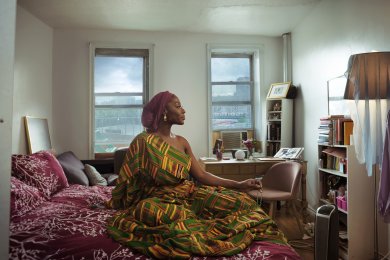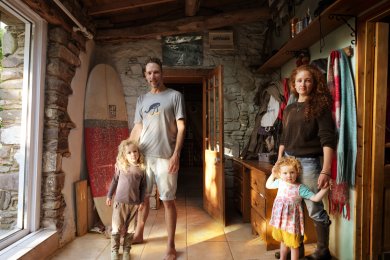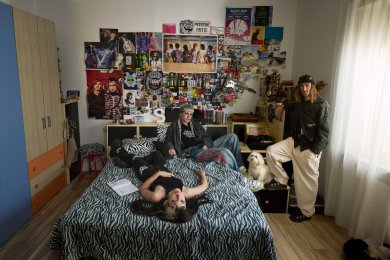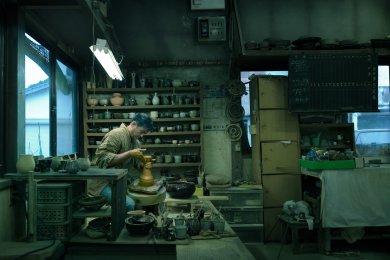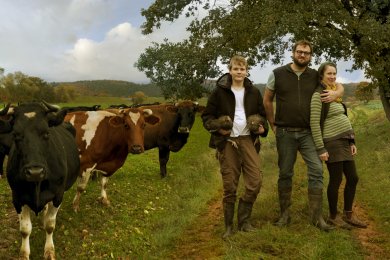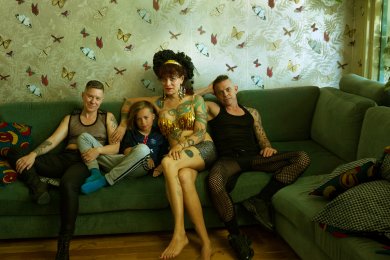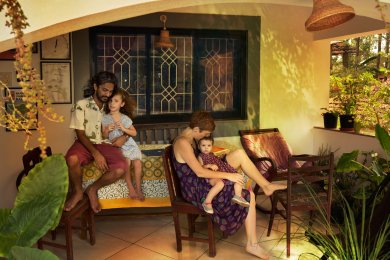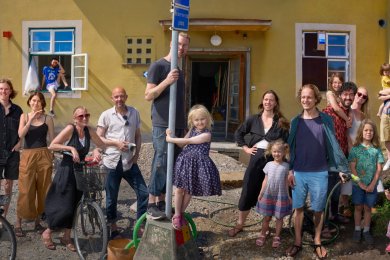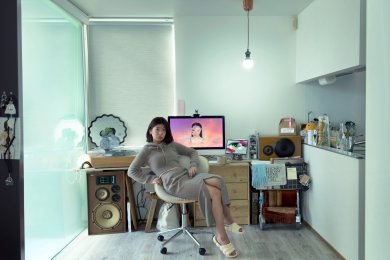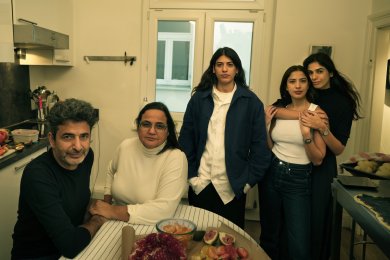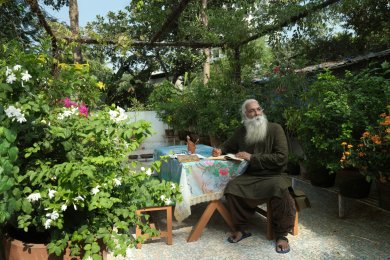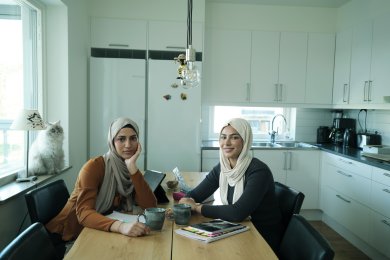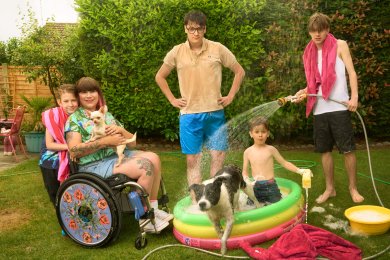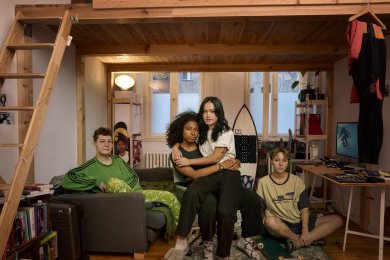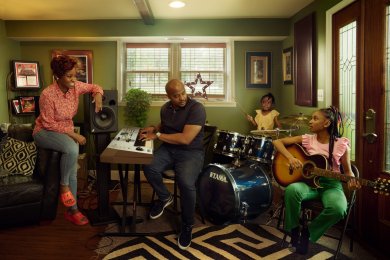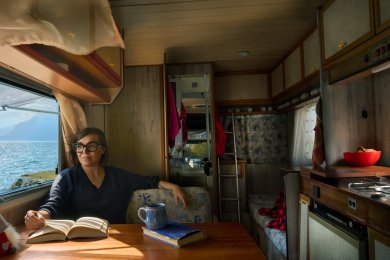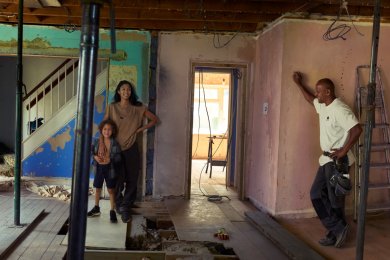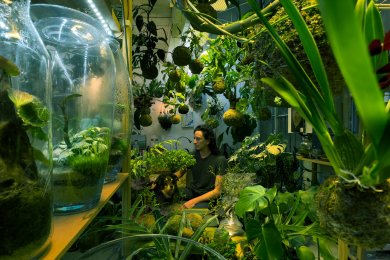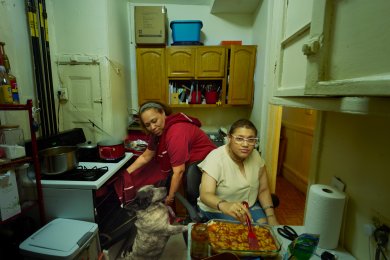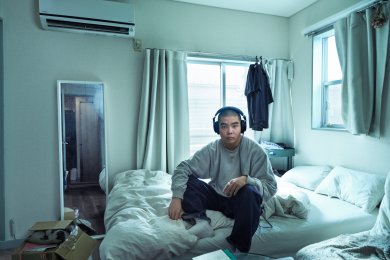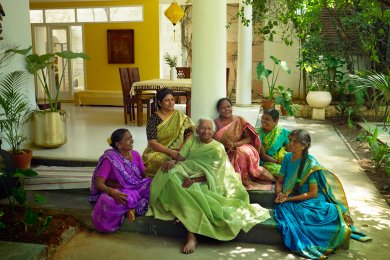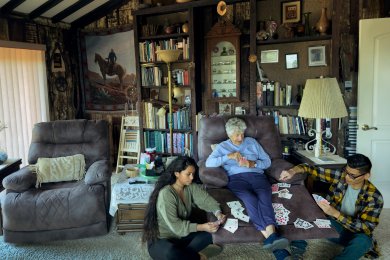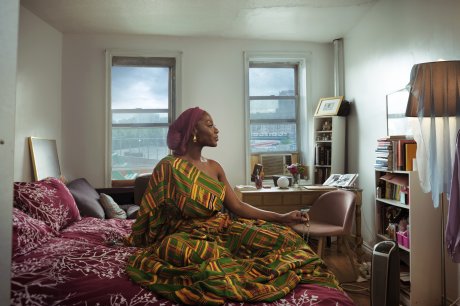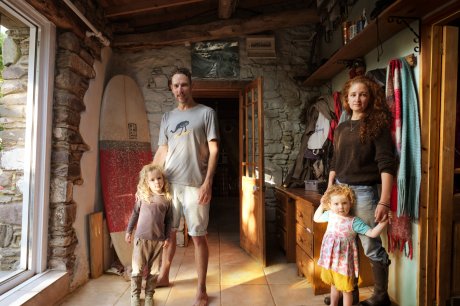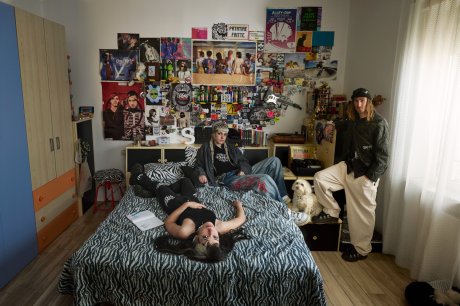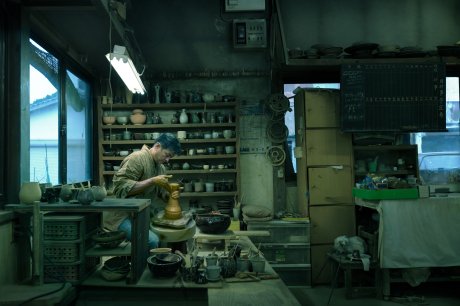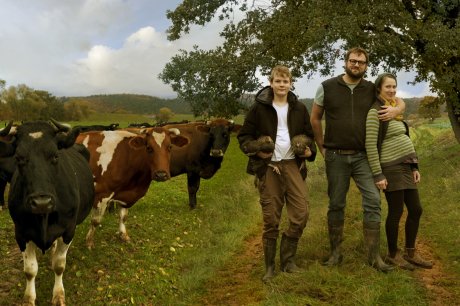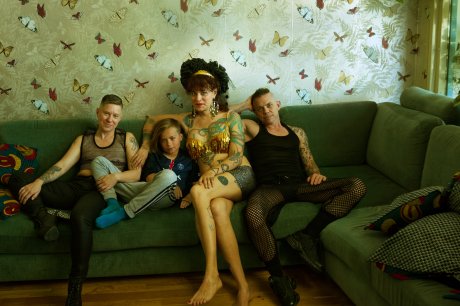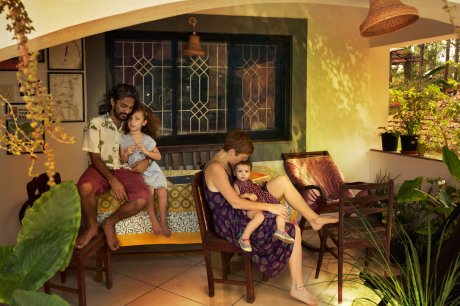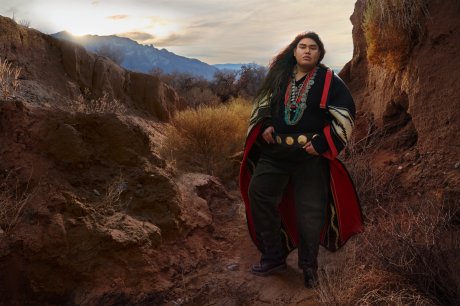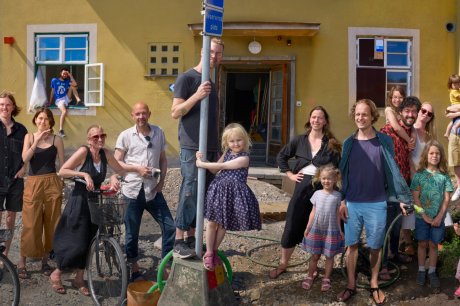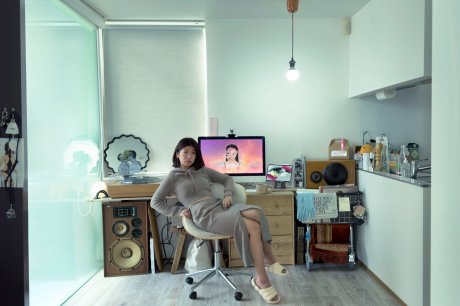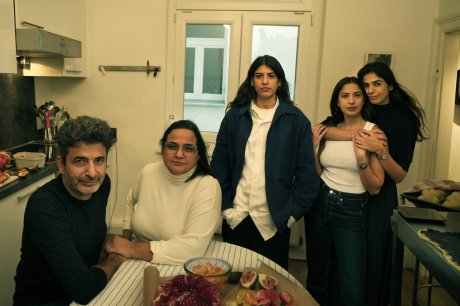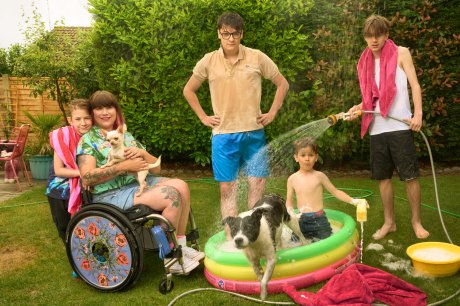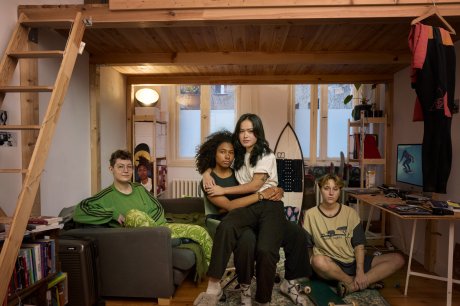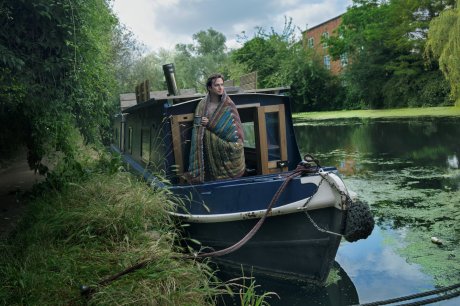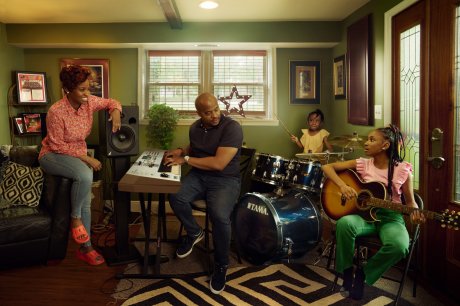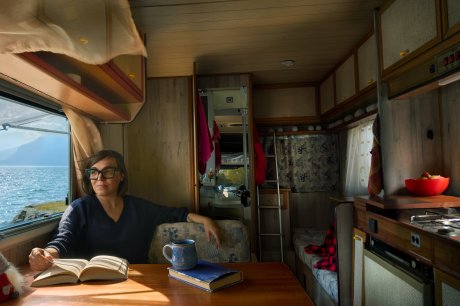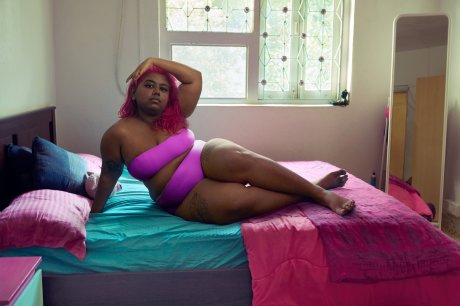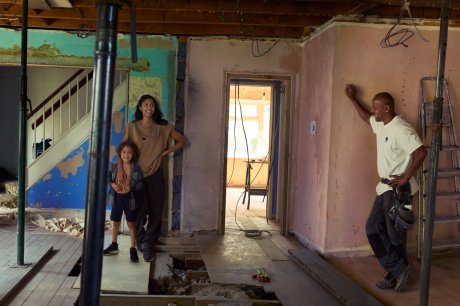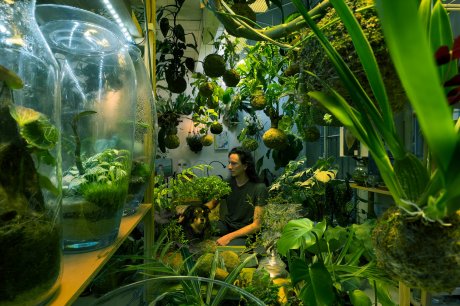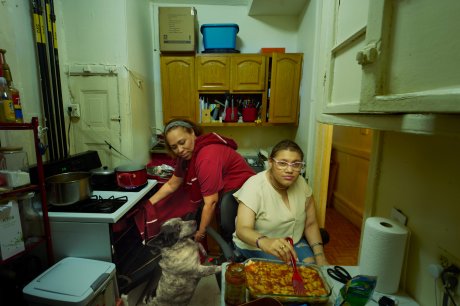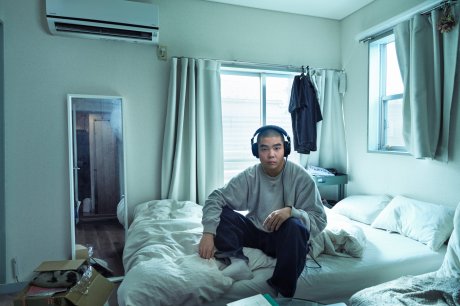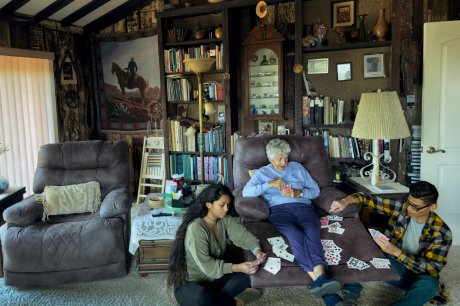Life at
Home
IKEA + Annie Leibovitz
Alongside iconic American photographer, Annie Leibovitz, we visited people in seven countries to produce a series of portraits that shine a light on the nuances of life at home.
No sets or stylists, just real people and real lives – a collection of 25 unique homes and stories from around the world.
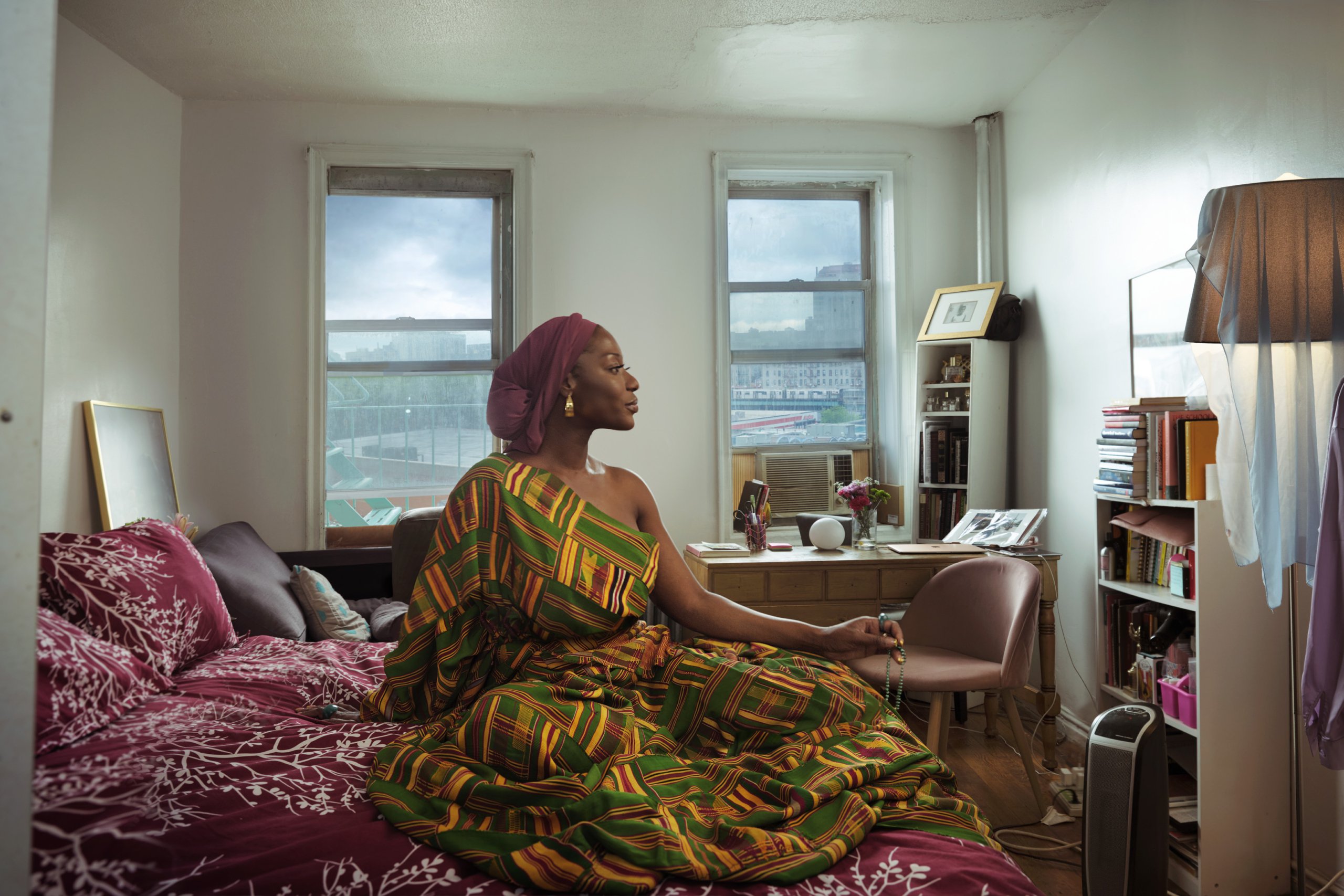
Rockyatu Otoo United States
Home 1 of 25
The space between
After returning from a life abroad to her childhood apartment in the Bronx, New York, Rockyatu Otoo found home in the quiet spaces between rooms where she could, quite simply, “exist.”

Francois Beyers United Kingdom
Home 2 of 25
Surfing, seaweed and serenity
Francois Beyers and his family run a seaweed and shellfish farm called Car-y-mor – “for the love of the sea” in Welsh. It’s the mantra that they follow as they live their lives at the water’s edge.
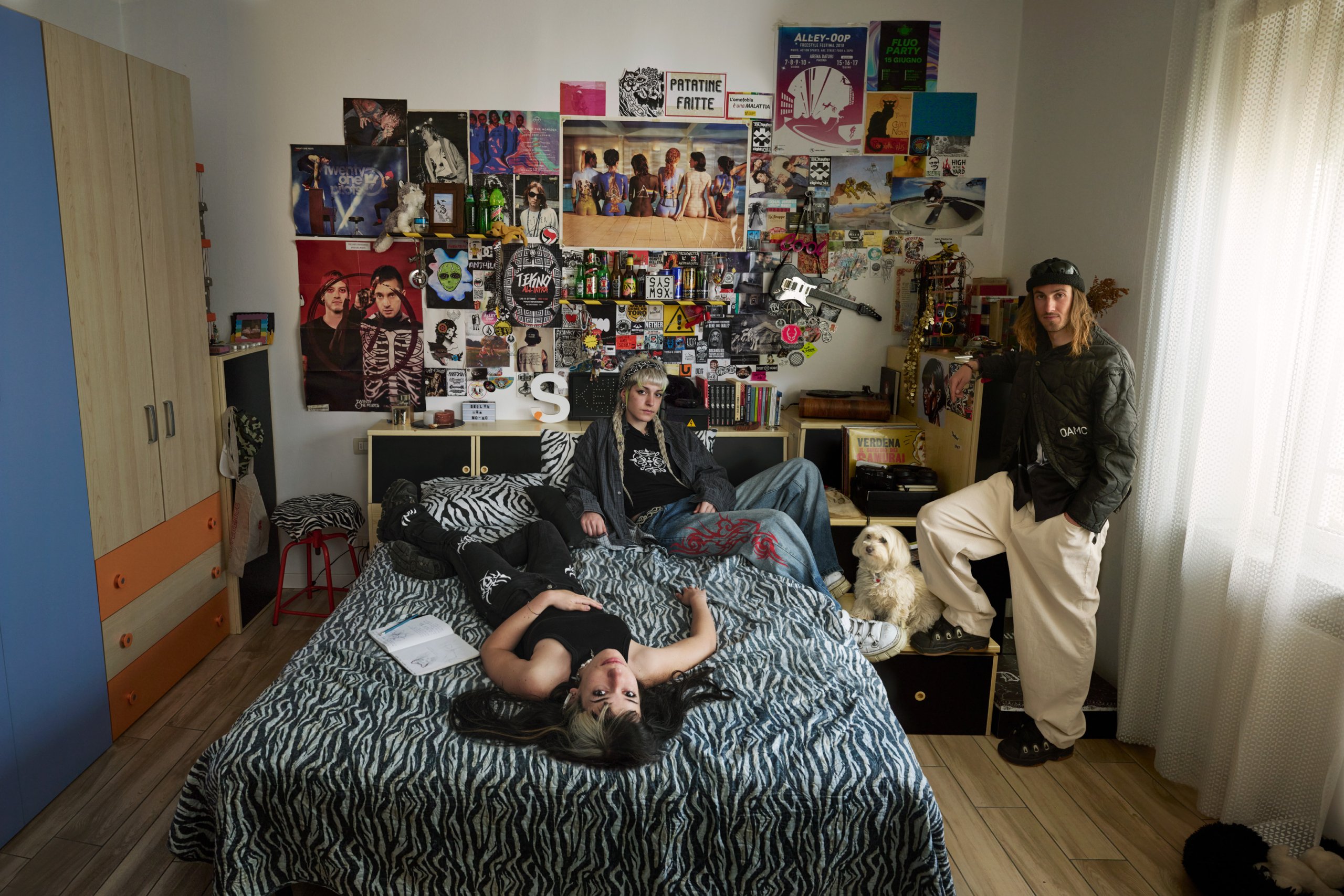
Silvia Ragusa Italy
Home 3 of 25
My happy place
Silvia Ragusa transformed her room in her family home close to Milan into her private haven. There, she says she can be herself, listen to music as loud as she wants and express her creativity.
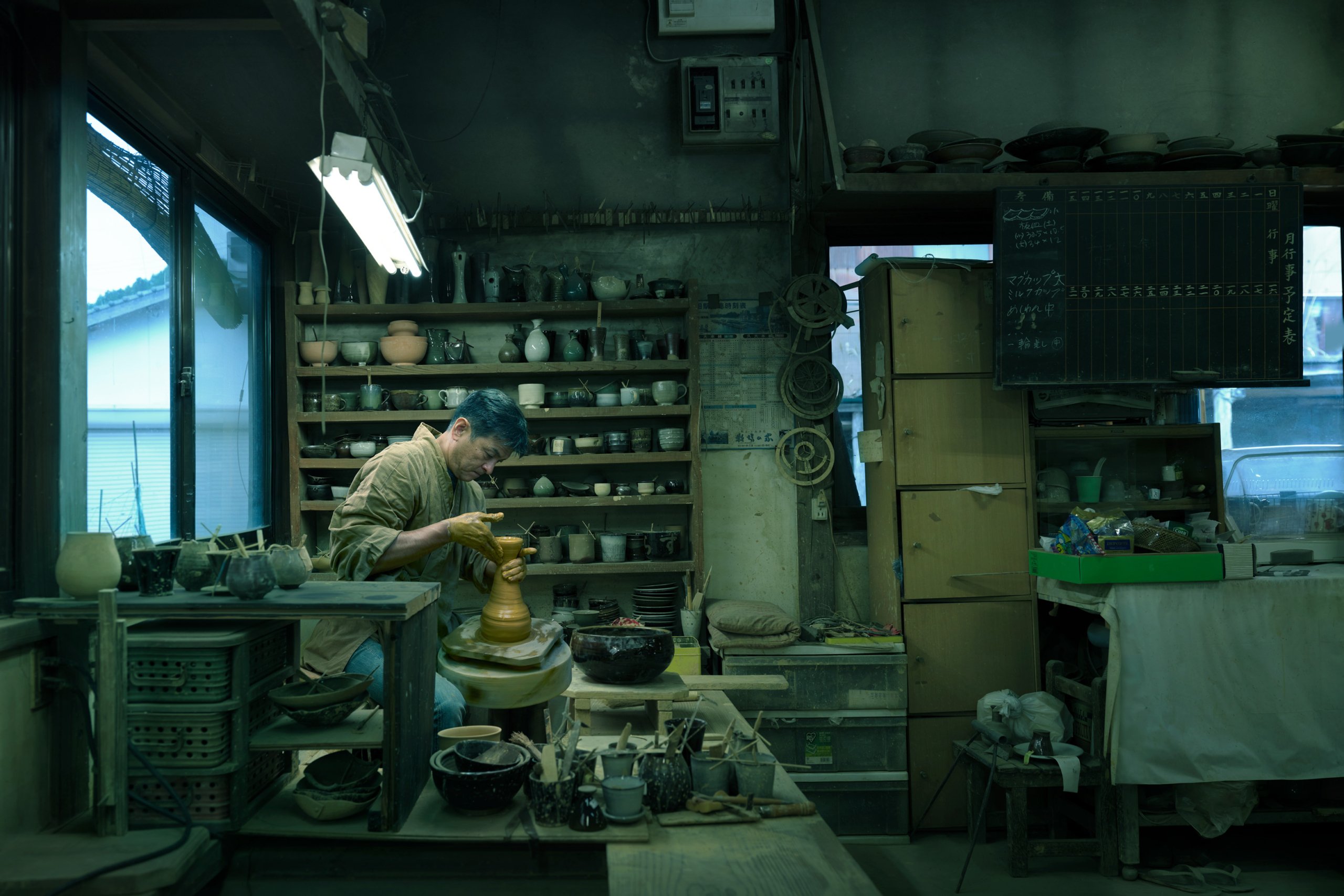
Yusuke Onimaru Japan
Home 4 of 25
A cup of tea with a ceramic artist
Ceramic artist Yusuke Onimaru has made Takatori Pottery in Fukuoka for over 30 years, sharing the potential of Takatori with the world. To do so, he says, he must reflect on his roots and the house where his ancestors lived.

Franziska Dörr Germany
Home 5 of 25
A home for people... and cows
The farm, the animals and work are all closely intertwined for Franziska Dörr and her partner. Their home, in a rural village in Germany’s North Hessian province, is also home to the pigs and cows they keep.
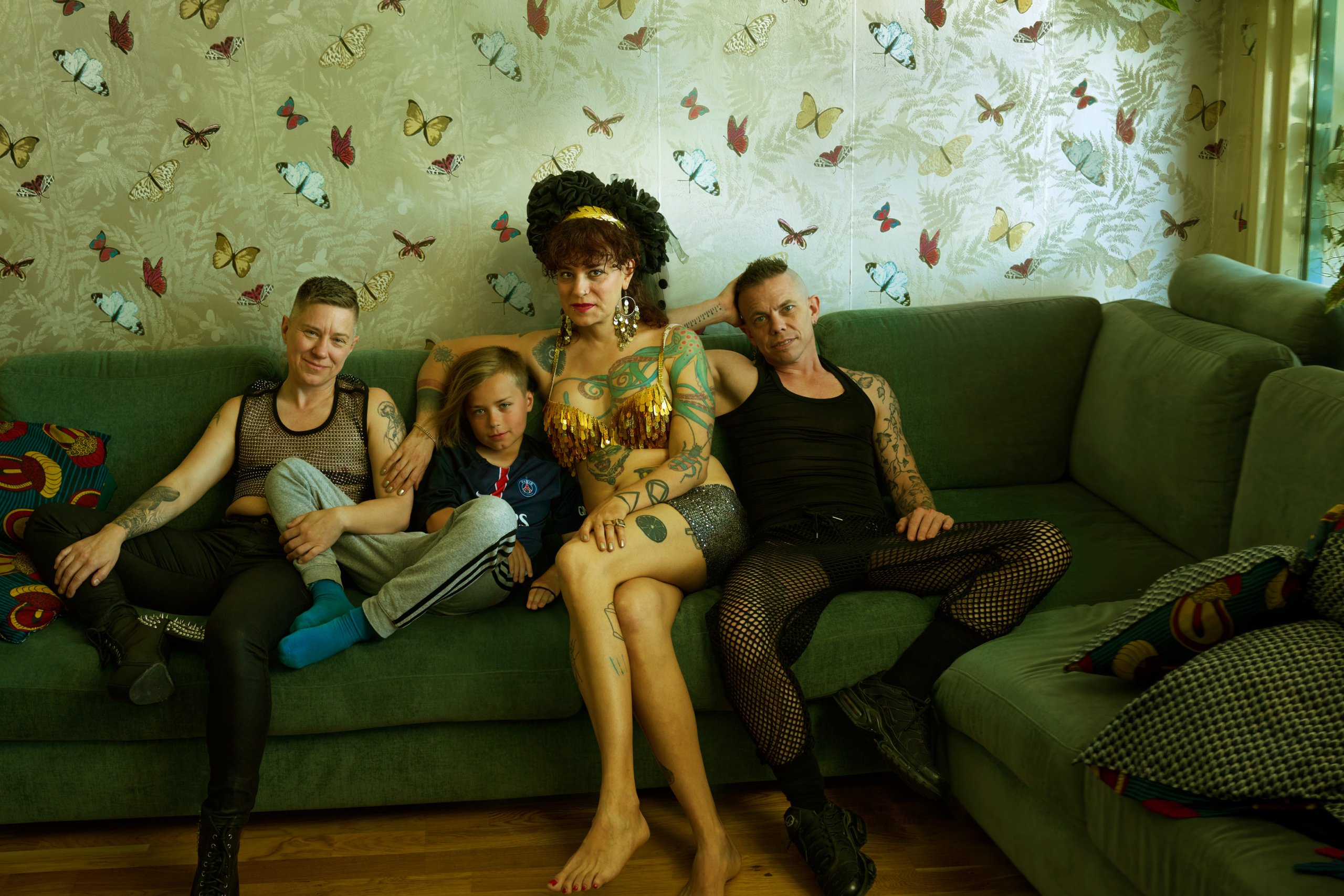
Cal Orre Sweden
Home 6 of 25
A home filled with people, patterns and plants
On one level, Cal Orre’s life at home is no different to other people’s. But the LGBT+ activist, who lives with their two co-parents and their child in a Stockholm suburb, says daily life can be different because of a poly-relationship home.

Safdar Rahman India
Home 7 of 25
Home is where
the heart is
Safdar Rahman and his wife have moved around a lot in life, but their North Goa home – rich in emotion, sentiment, and the joyful chaos of their two young daughters and pet dog – embodies how settled they have become.
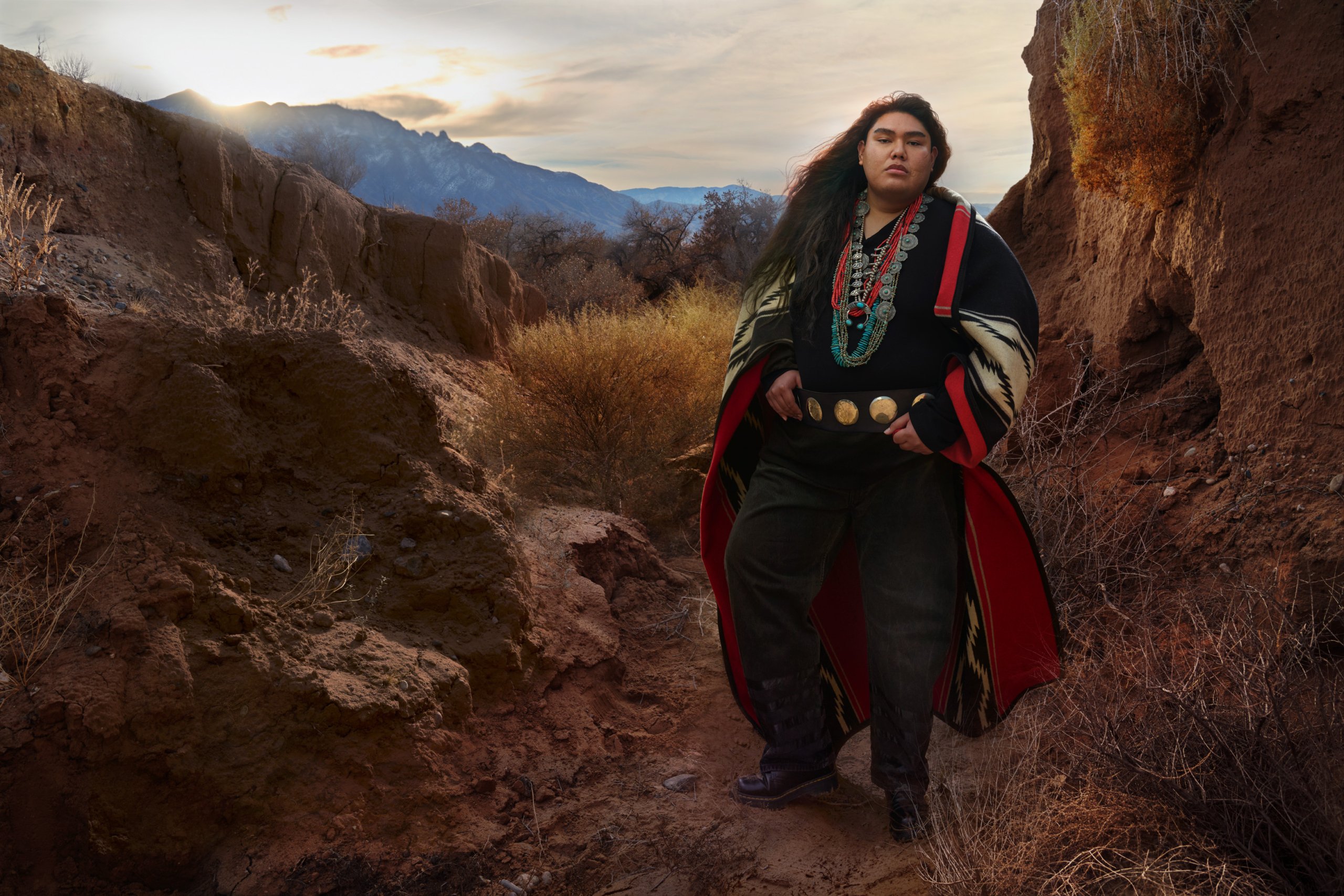
Kymon Greyhorse United States
Home 8 of 25
A place to be proud
Kymon Greyhorse lives with his mother in a cozy home in New Mexico, where he creates work that seeks to amplify the indigenous voices of his dual Navajo and Tongan ancestry.
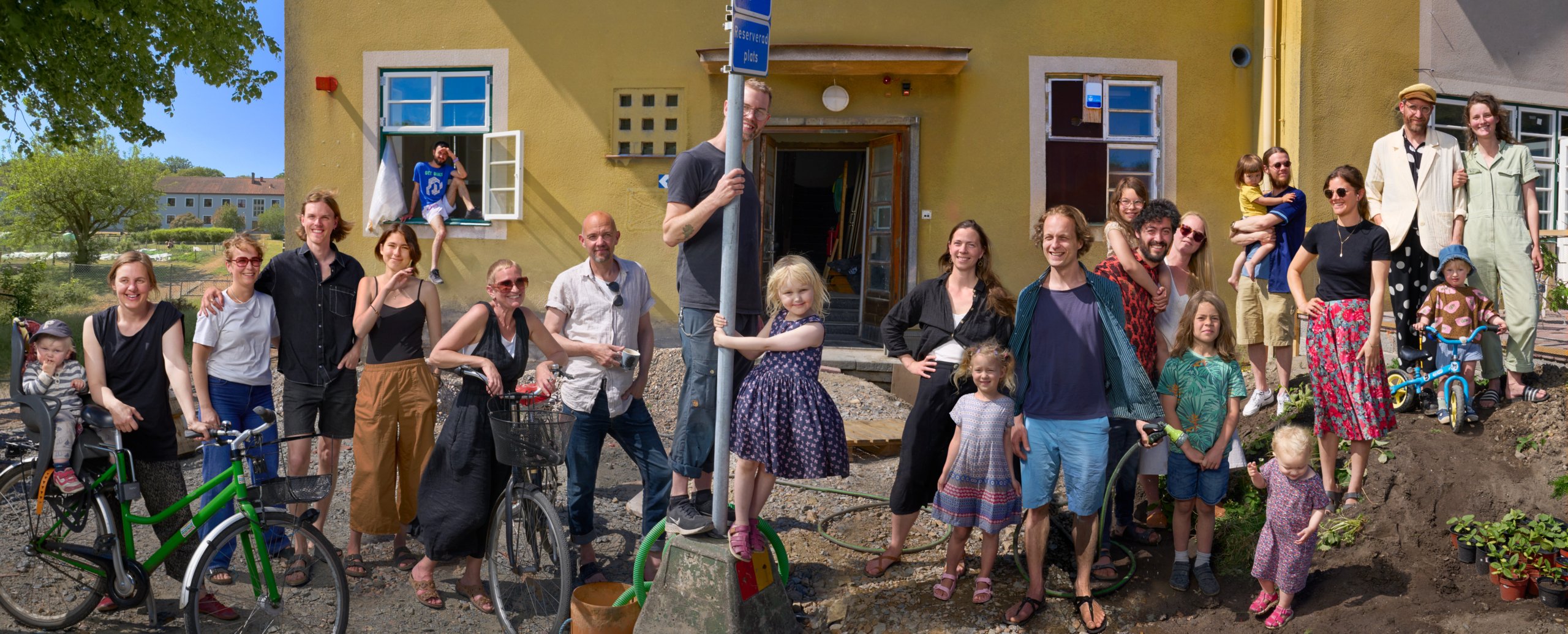
Ludvig Haav Sweden
Home 9 of 25
Meaningful lives, meaningful homes
Ludvig Haav is the vision and force behind a newly established co-housing project in Malmo. Redefining the standard definition of ‘home,’ the project offers the world an alternative way of living.
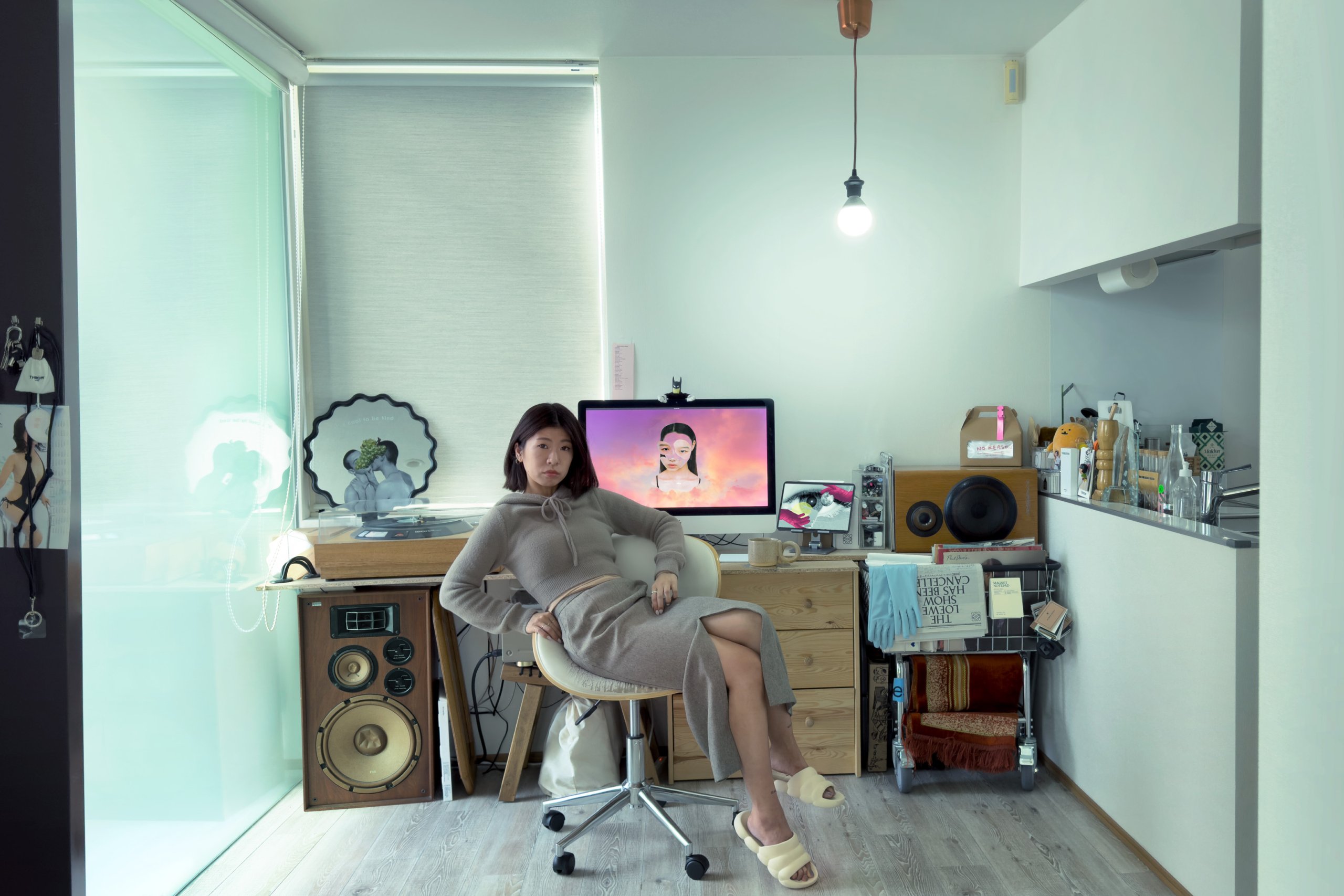
Manami Miyamoto Japan
Home 10 of 25
A mosaic of memories
Collage artist Manami Miyamoto’s room is filled with things she’s collected over the years. For her, home is like a collage. A combination of her favourites intertwined with found treasures that create harmony.
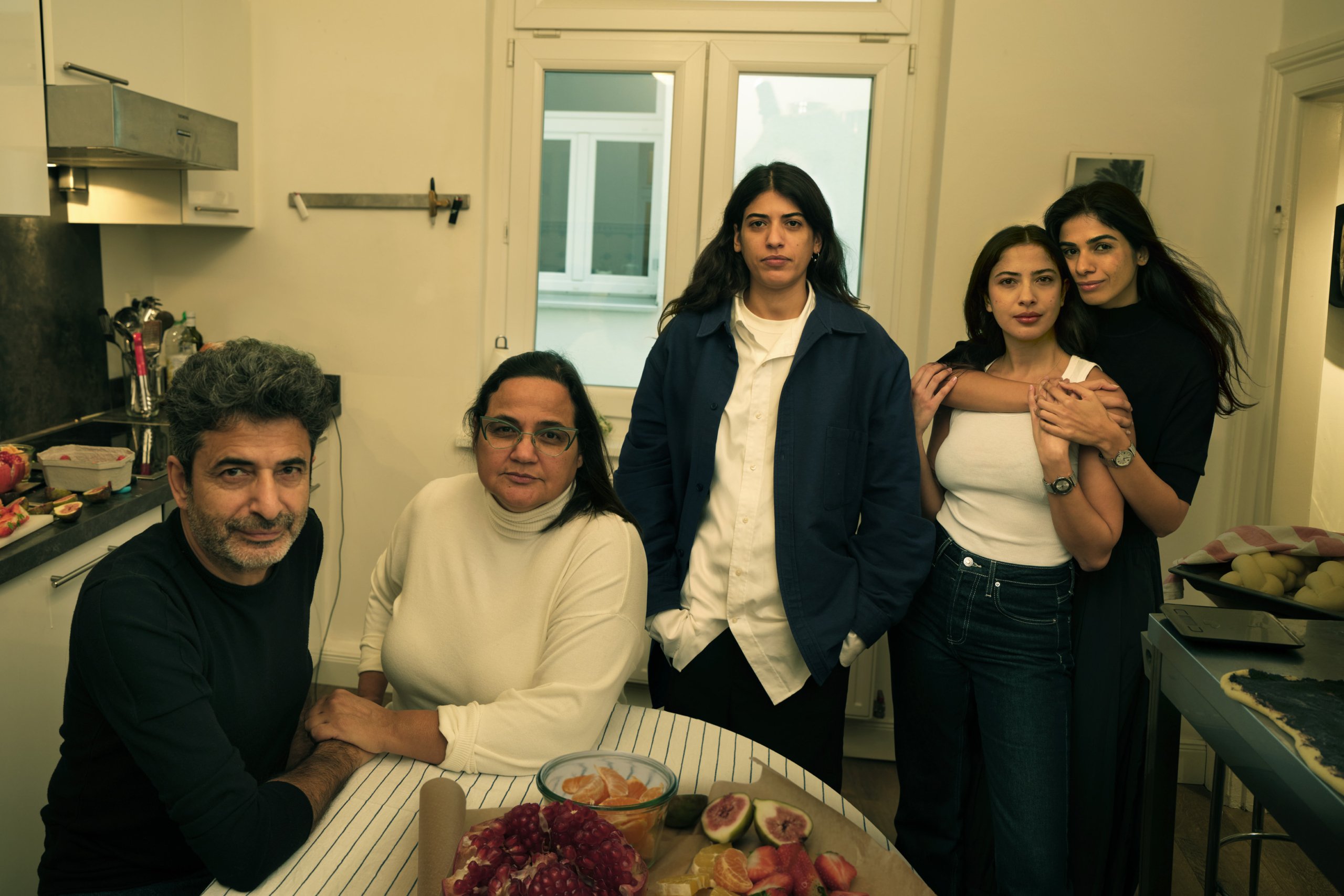
Toar Avni Germany
Home 11 of 25
Love and life in a Hamburg home
For Toar Avni, home is everything. Toar’s aim is for people “to encounter a feeling of love” when they enter the home in one of Hamburg’s most popular areas.
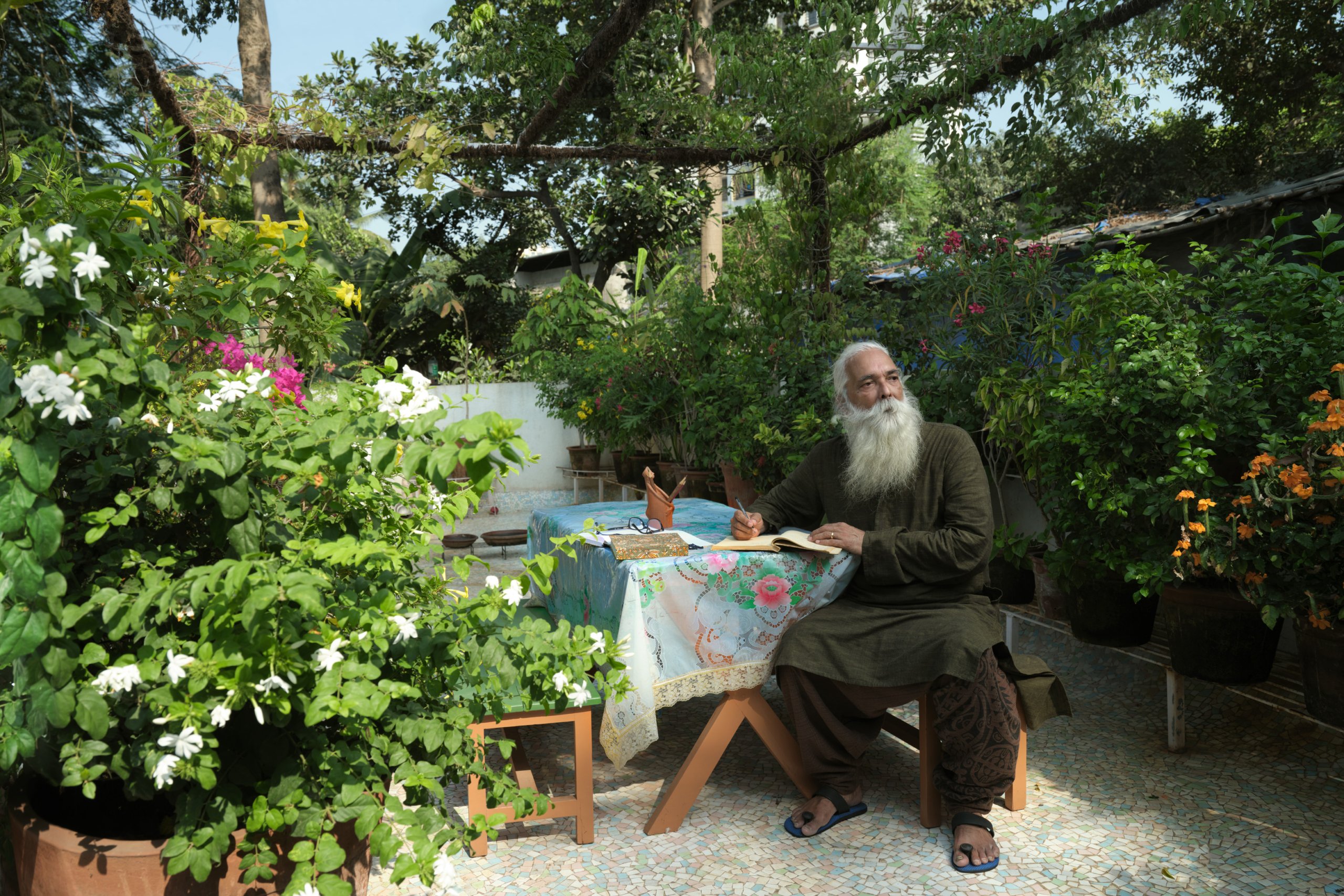
Gangadharan Menon India
Home 12 of 25
Multigenerational living
Housing four generations, Gangadharan Menon’s three-bedroom home in one of Mumbai’s last few villages blurs the lines between indoors and outdoors, memory and imagination, identity and environment.
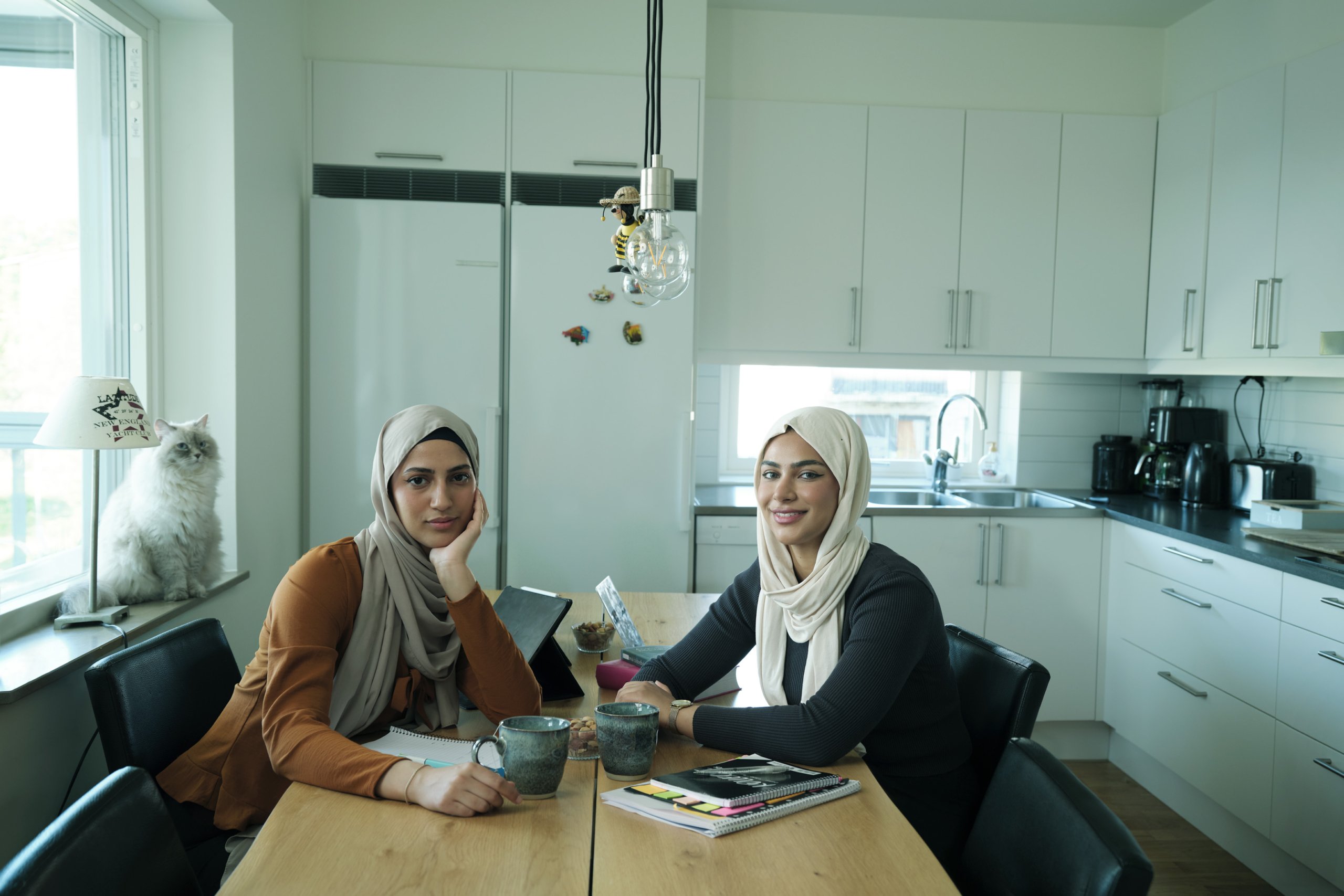
Elaf Kamil Sweden
Home 13 of 25
A new life in Sweden
Born in Iraq and raised in southern Sweden, Elaf Kamil and her sister, Sarah built a new life learning about Swedish culture, discovering letterboxes and finding adventures... at IKEA.
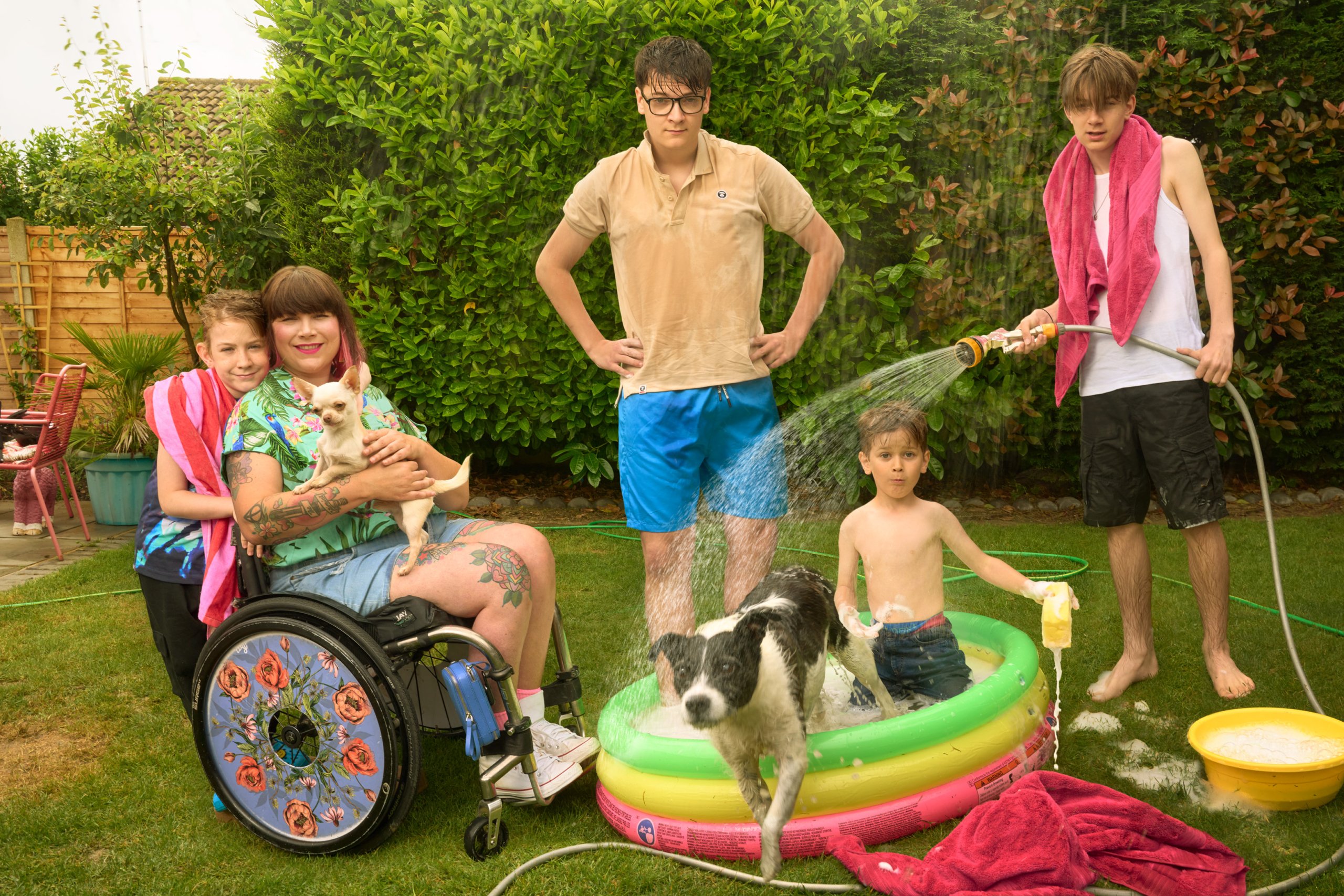
Nina Tame United Kingdom
Home 14 of 25
Comfort in the chaos
Nina Tame describes her household as “chaotic”, shared by two parents, four children, two puppies, one dog and a cat. But the hustle and bustle contribute to a vibrant dynamic that “just works.”
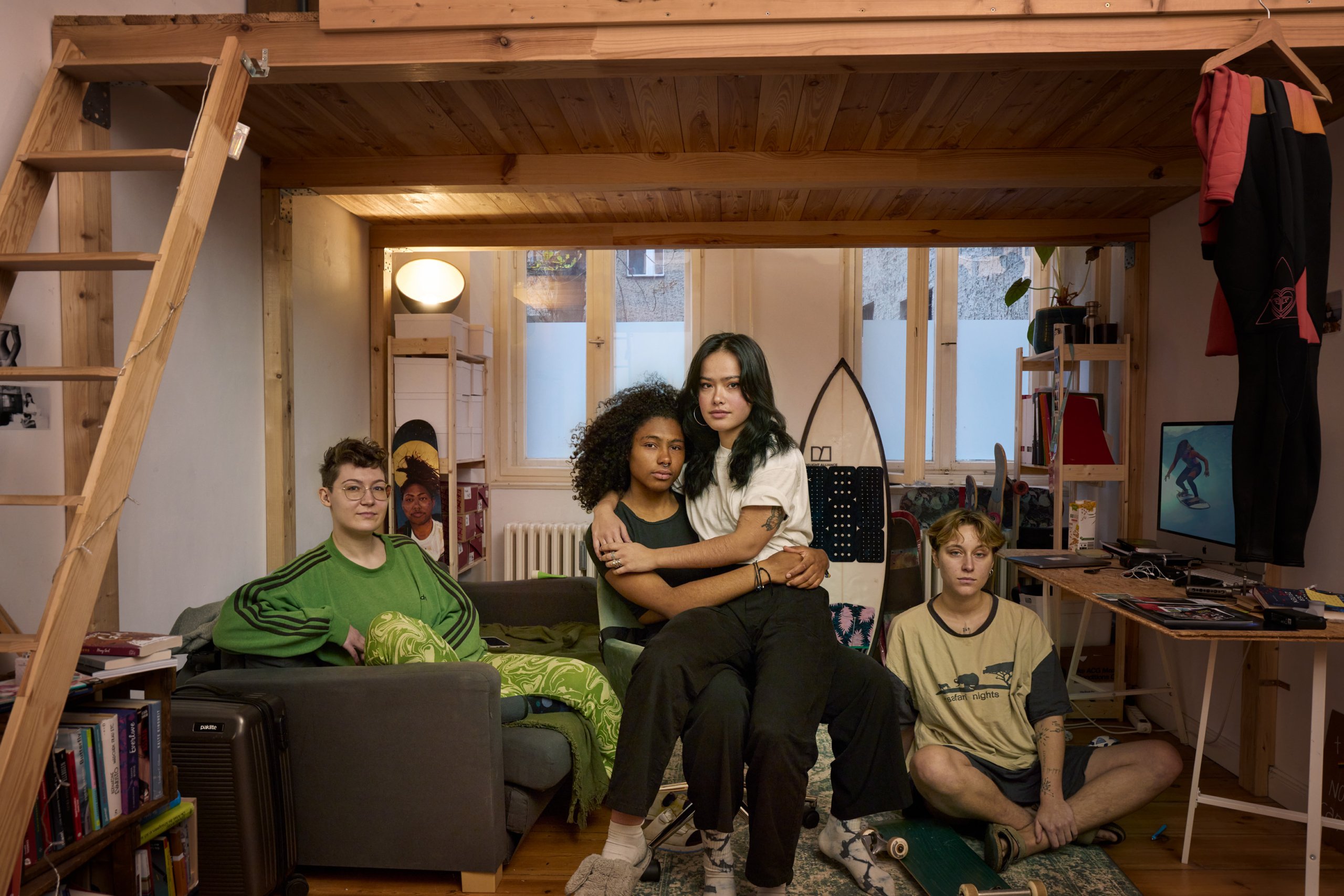
Maria Arrechea Germany
Home 15 of 25
From pavement to purpose
Balancing on boards is as important as balancing life for Maria Arrechea. The Berlin-based creative is able to find calm at home amid an active lifestyle.
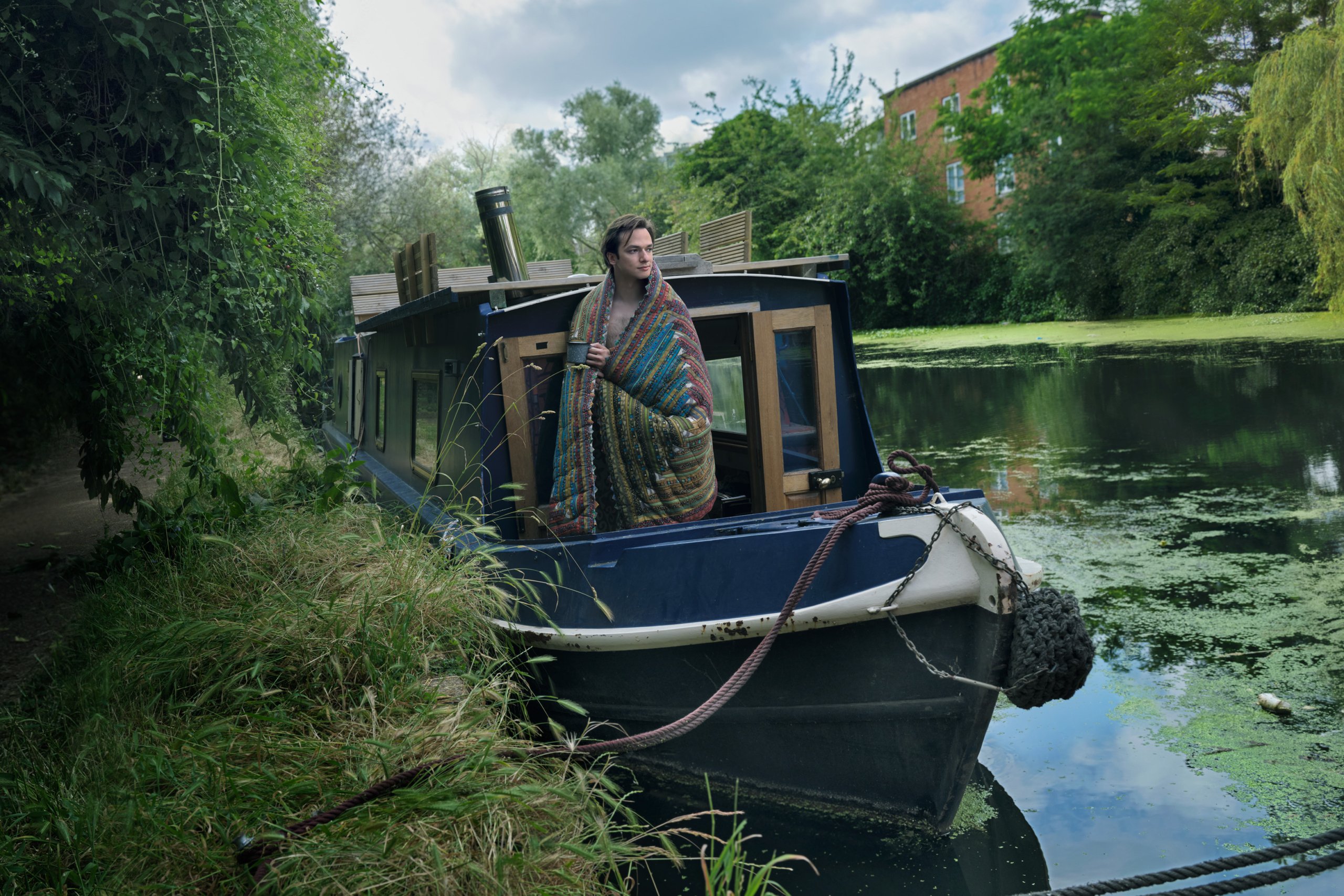
Arslan Zhunus United Kingdom
Home 16 of 25
Living off-grid on a boat in London
Moored on the banks of the River Lea in East London, Kazakh-born Arslan Zhunus leads a somewhat unconventional life in his narrow boat home.
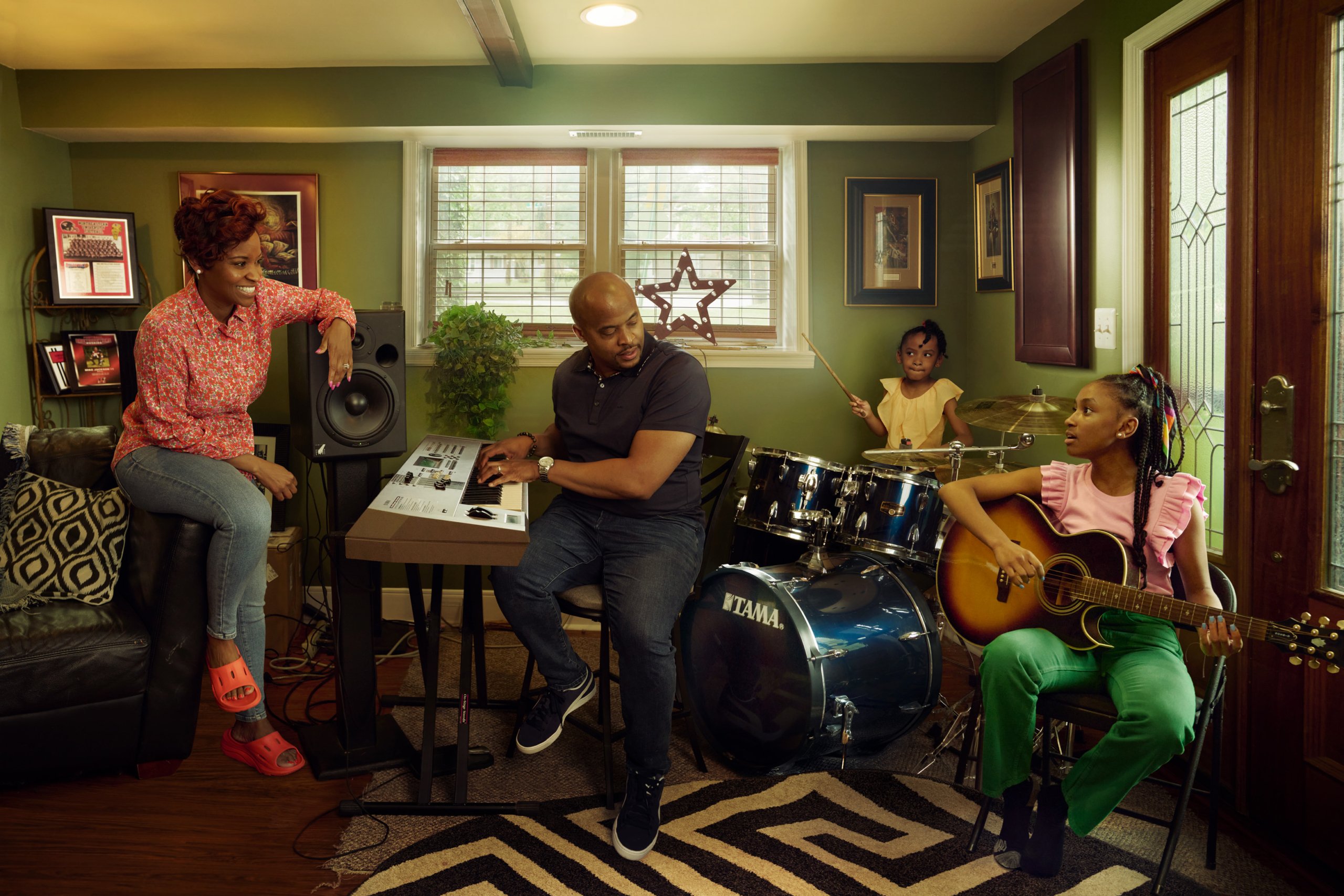
Michael Jackson United States
Home 17 of 25
Open-format living
Devoted husband and father of two girls, Michael Jackson never imagined all the ways creating a family would change his life – eliminating his privacy but providing a love for connection and community that has become essential to his idea of home.
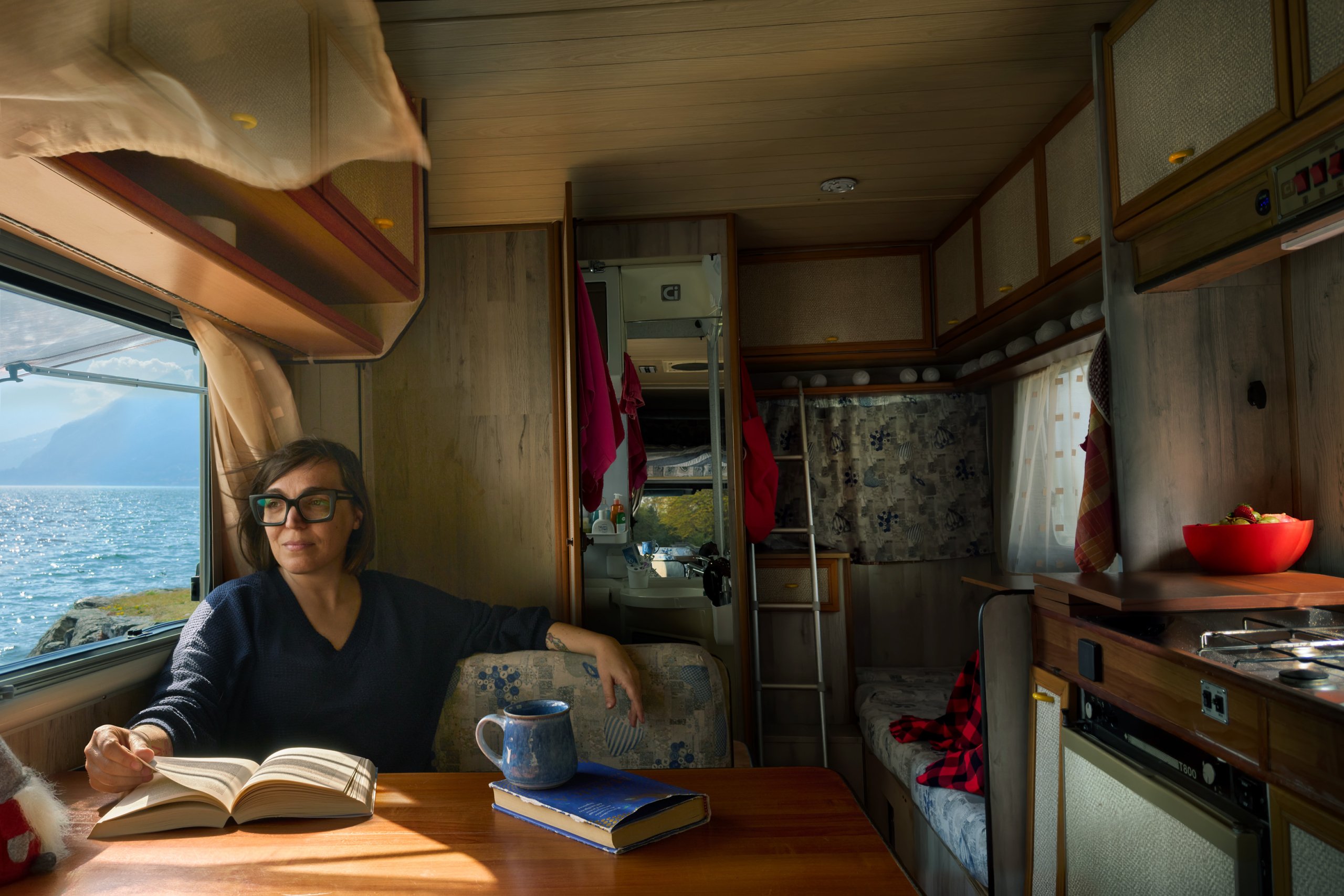
Sharon Sala Italy
Home 18 of 25
Life on wheels
Sharon Sala moved 18 times before deciding to change her lifestyle and move into a camper van. Now, she feels truly at home and begins every day with a different view.
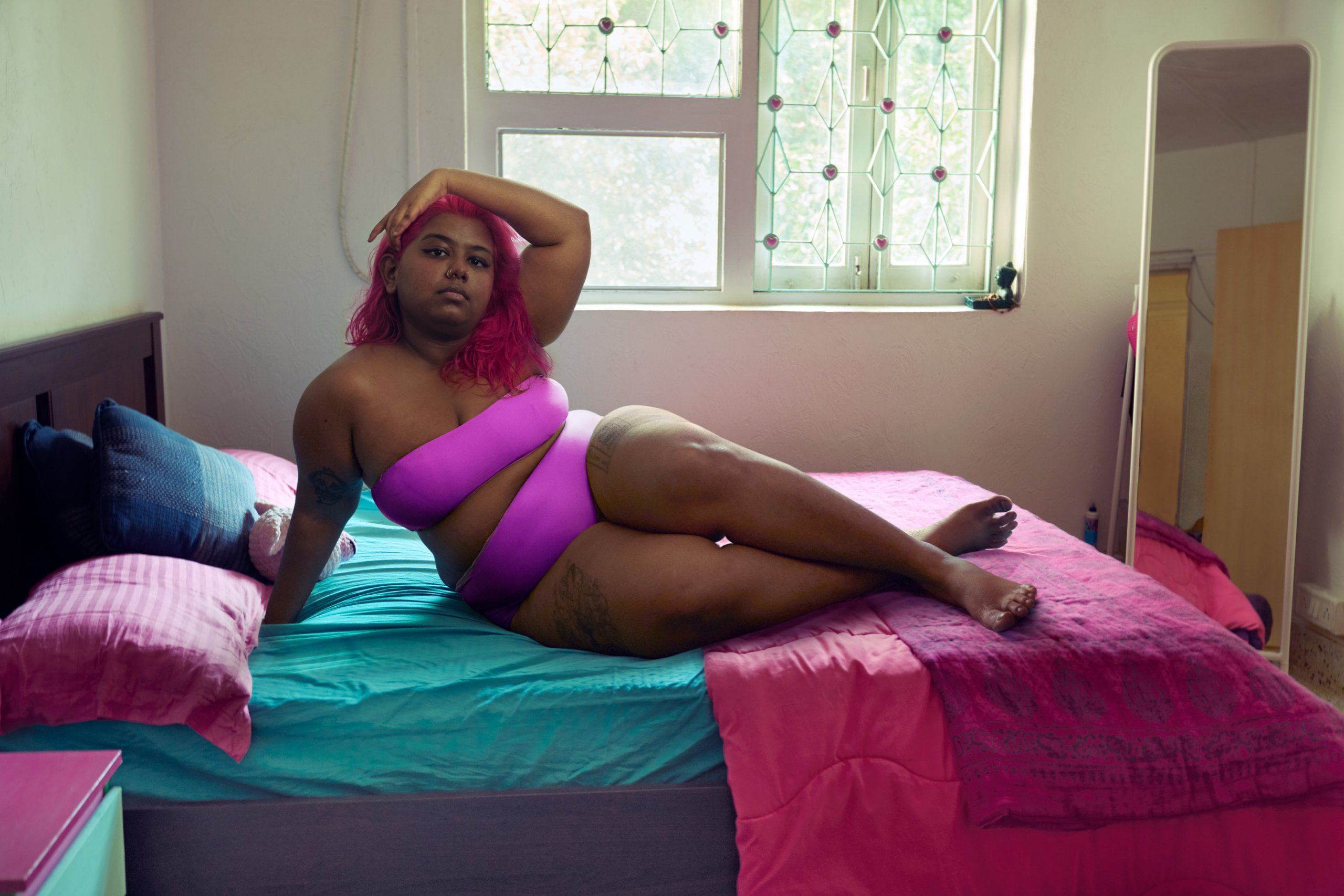
Priyanka Paul India
Home 19 of 25
‘I feel like a real person here’
For artist-activist, Priyanka Paul, the two-bedroom apartment is a sanctuary, a playground and a canvas all in one. When not fighting passionately for the causes Priyanka believes in, the home becomes a place of rest and sleep.

Carly Plunkett United Kingdom
Home 20 of 25
Pride of place
For Carly Plunkett, her new home is a reflection of years of hard work, love and sacrifice. Tirelessly working with her dad, she built a home for herself and her young son in London. This is the home where she now creates “beautiful new memories”.
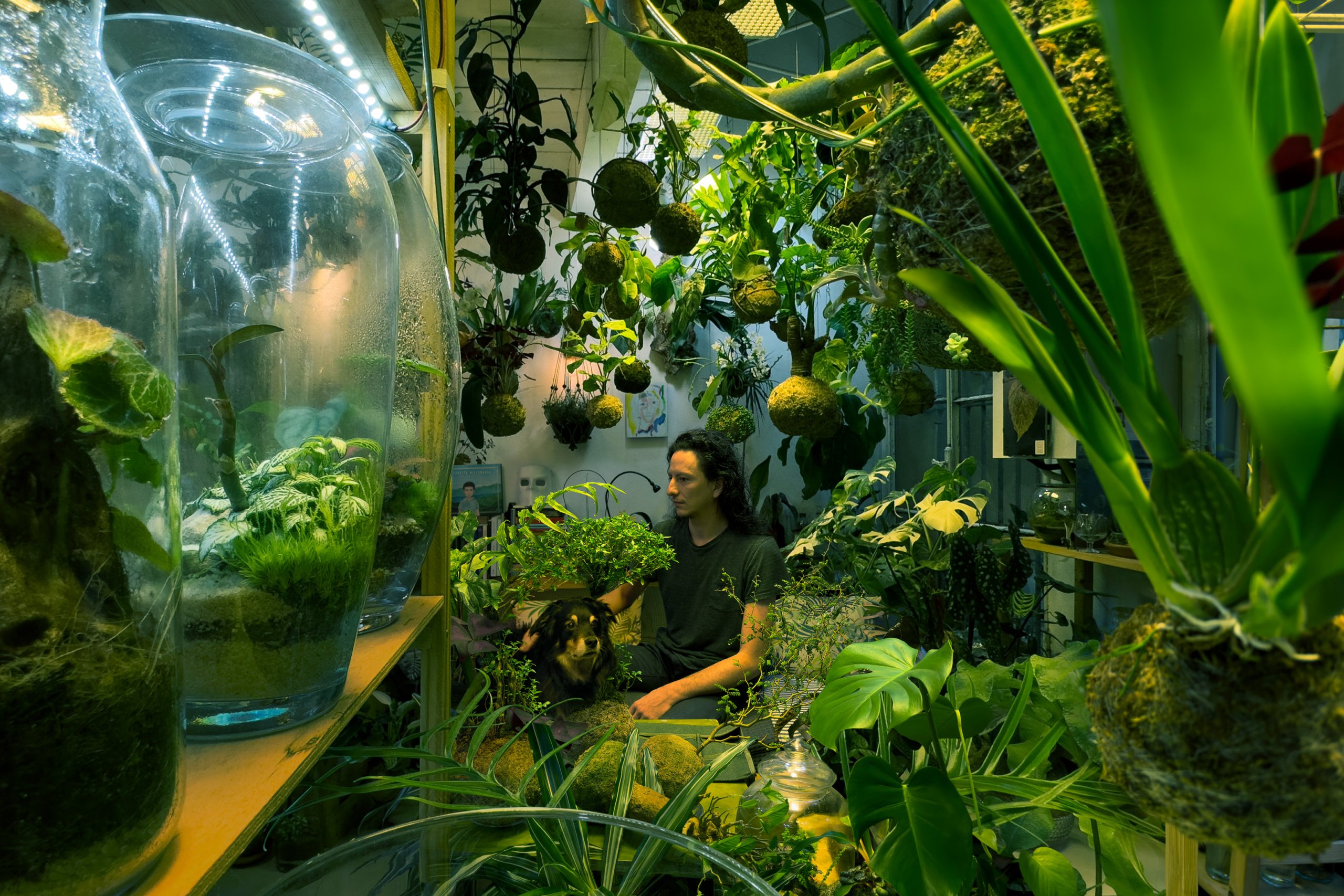
Giovanni Laguzzi Italy
Home 21 of 25
An oasis in an urban jungle
Giovanni Laguzzi’s passion for plants inspired him to quit his job, transform his rental apartment in Milan into a Japanese-style garden and start the business of his dreams.
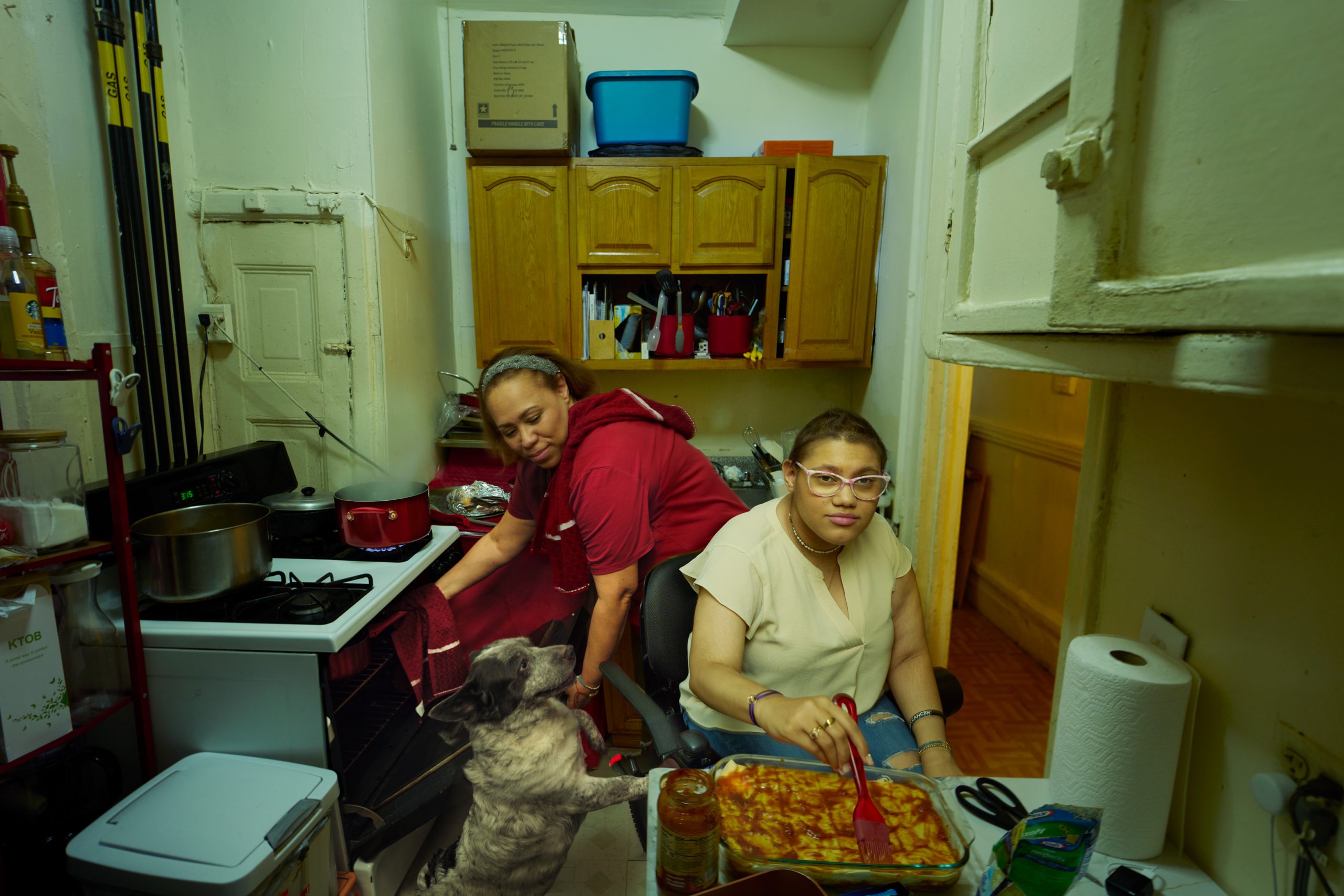
Daphne Frias United States
Home 22 of 25
Home is a movement
A youth activist, medical student and champion for the disabled community, Daphne Frias travels the world to promote her inspiring values – but she always returns home to recharge her batteries.
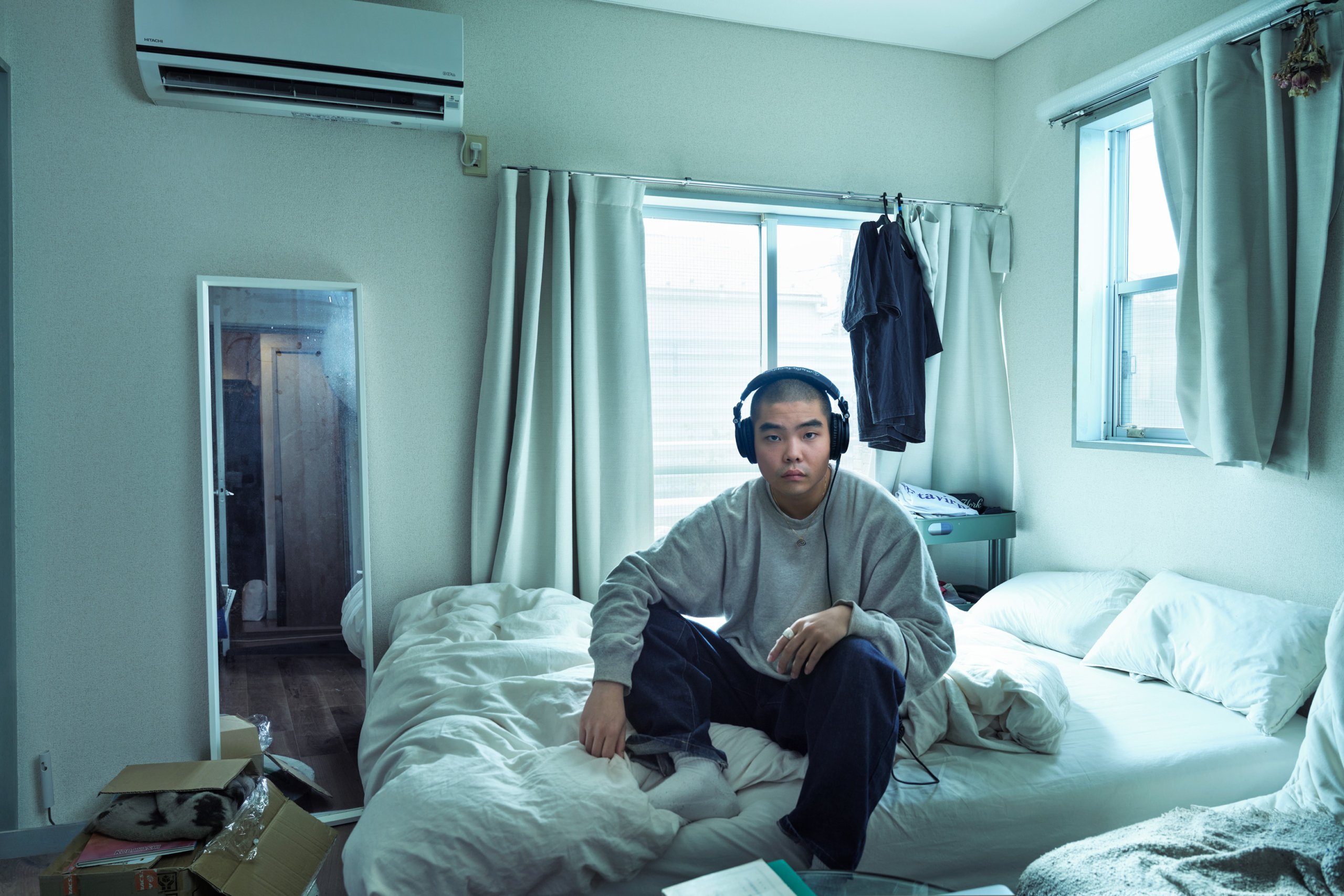
Sota Yamashita Japan
Home 23 of 25
Living in harmony with tunes and trends
He started DJing because he loved music. He launched his fashion brand because he loved fashion. Now, living in a compact Tokyo apartment, he immerses himself in projects that bring him the most joy.
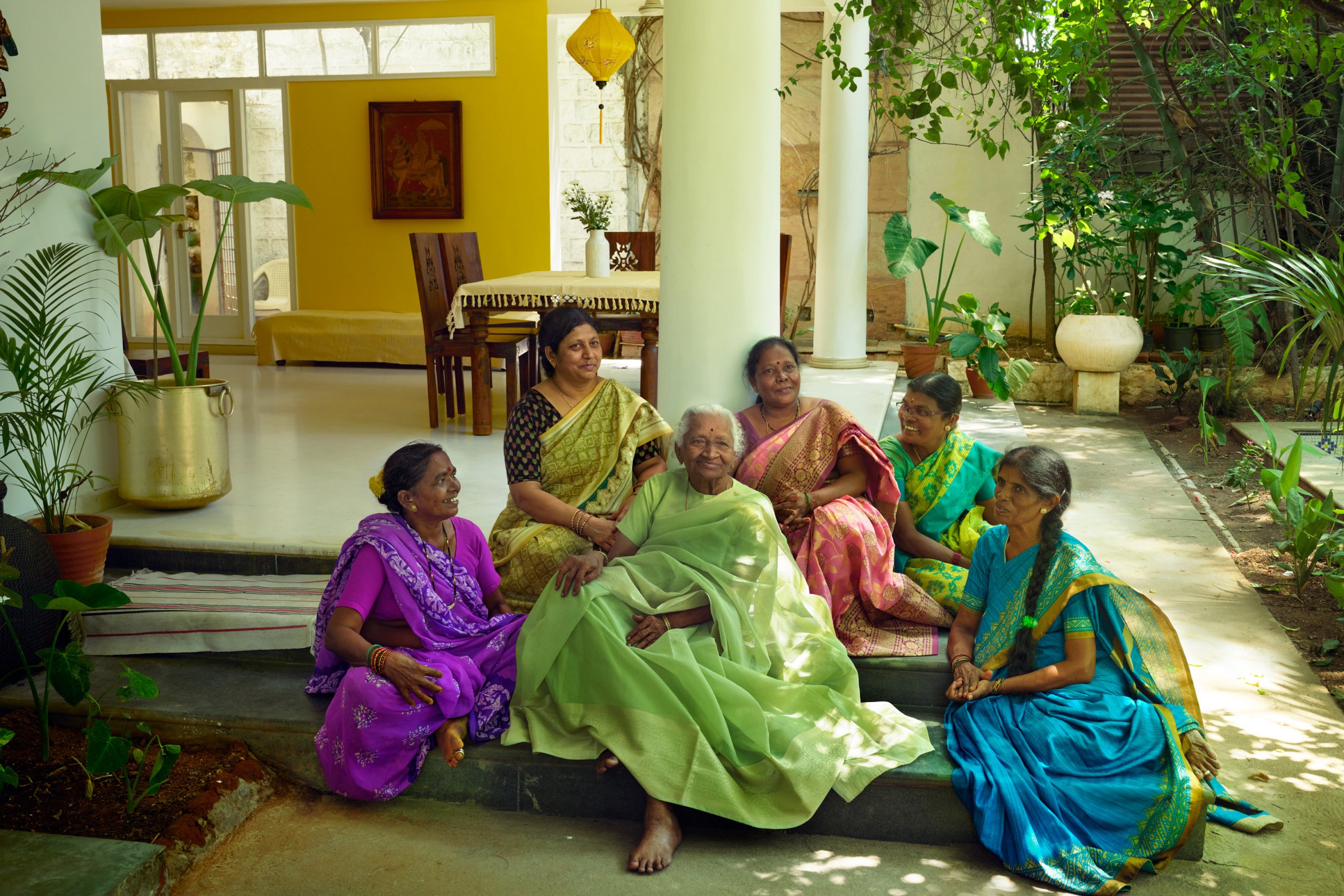
Revathi Thangavelu India
Home 24 of 25
An open house
At 92, Revathi Thangavelu has a zest for life that is rare in people decades younger than her. Her home is a combination of physical spaces brought to life with memory and experience.
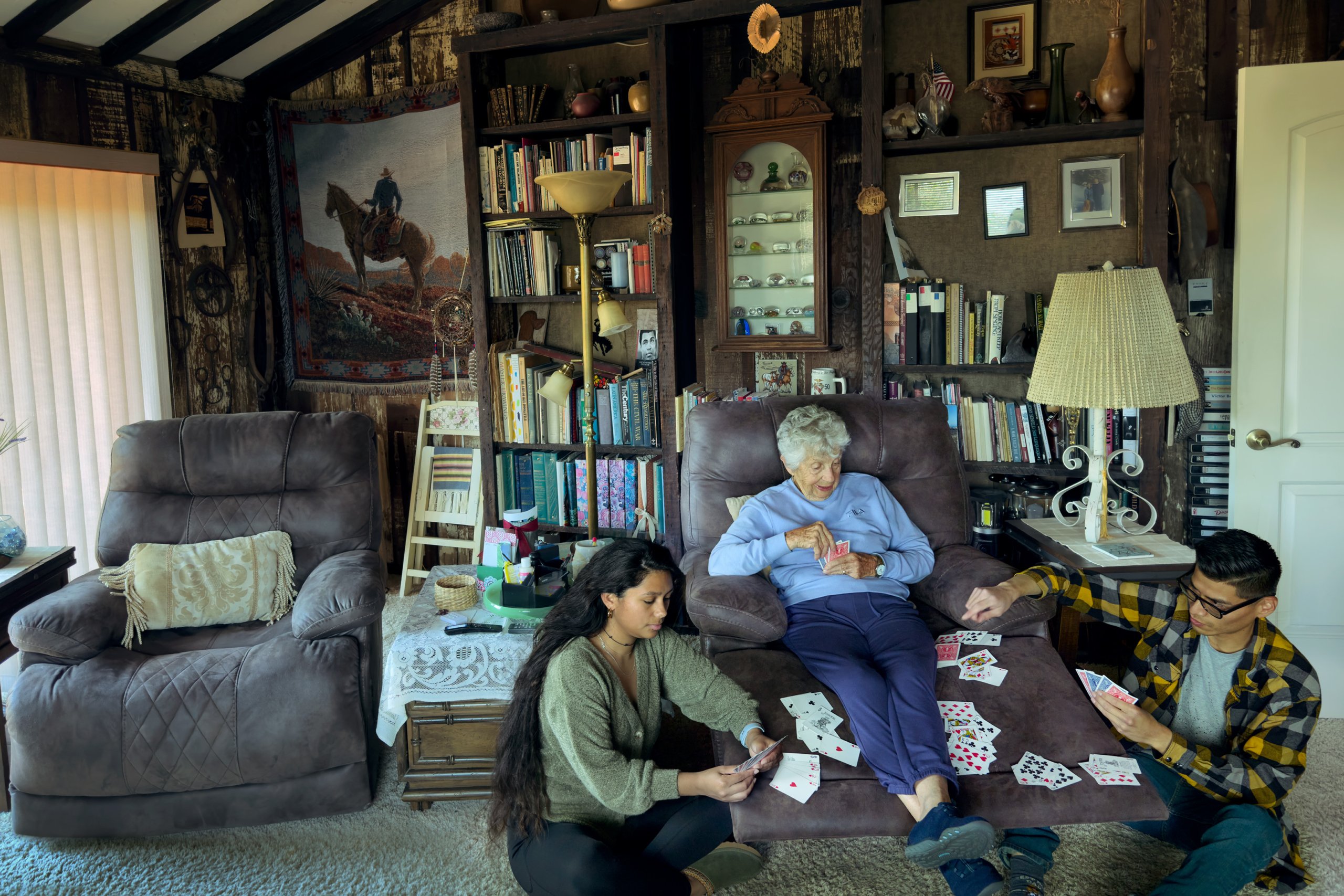
Raul Elias United States
Home 25 of 25
A safe space to learn
At the age of four, Raul Elias moved from a small town in Mexico to California. Now, home has become a place where he feels safe to learn and unafraid of making mistakes or asking questions.
The space between
After returning from a life abroad to her childhood apartment in the Bronx, New York, where she now lives with her brother and sister, Rockyatu Otoo found home in the quiet spaces between rooms, where she could, quite simply, “exist.”

Rockyatu Otoo, New York, United States
A promising start
Rockyatu Otoo, 31, was born in a stone-colored building with a grand, Victorian entrance in The Bronx, New York. Her Ghanese mother and father raised her and her siblings in a sprawling five-bedroom apartment on the 15th floor, with windows overlooking a playground across the street and the busy sidewalks below.
As a child, she shared a bedroom in the back of the apartment with her younger sister, and it was there that she discovered her love of books. She spent many hours throughout her childhood reading in a sunlit corner of the room – a corner that is still, today, where she goes to recharge her batteries. She always loved her hometown, and after graduating from college, she thought she would find happiness and fulfillment by pursuing a stable job with a regular schedule. She was employed by a non-profit and enjoyed her work – but after a few years she felt stuck, and she began to look beyond the borders of her daily life for a different kind of experience.
“I thought that by getting that 9-5, my life would be excellent, and I could just relax,” she says. “I wanted to settle into a working routine and enjoy living here. But I got to a point where I just felt, I want to do something else, I’m a little bit bored. I don’t think this is it for me; I wasn’t sure it was what I felt fulfilled by.”
A journey abroad
Despite having acquired the trappings of a traditionally successful lifestyle, something didn’t feel right. So, in 2015, she decided to leave her family’s apartment in the Bronx – and the comforts of the familiar – and to move to Spain to teach English.
“I was really motivated by just discovering the world,” she reflects. “And through working with three different schools teaching English, I fell in love with the classroom. I had no idea that I would love teaching the way that I did, the idea of creating an entirely different space for the students and myself.”
It was while living abroad that she missed New York, for the first time in her life. She missed the energy, the culture, the pace of life, and she understood that she would likely never find another city that could replace what her hometown represented to her.
“You have to leave New York to really understand how unique this place is,” she says. “I really was able to appreciate that fact, and I realised I will always have to have a home base in New York, no matter what. But I left Spain in peace, and I came back here knowing that I wanted to be working as an educator and working with kids.”
The path back home
Luckily, she was able to return to a safe environment: her childhood apartment, where her brother and sister were still living. Her mother had recently returned to Ghana, so Rockyatu and her siblings became the caretakers of their home. She found work teaching third grade in a charter school and continues to dream about creating her own curriculum, potentially for adults as well as children.
Returning to this familiar space as an adult, with life experience behind her, Rockyatu was able to see and to experience the rooms she knew so well in a completely different way.
“There are little places around the apartment that I’ve discovered as an adult that I didn’t even notice as a child, when I was just speeding through this place,” she says. “As an adult, I can be a lot slower, I can take introspective time to reflect on what’s here, and I’ve enjoyed that. COVID also invited me to really make sense of home, and be at home, as opposed to treating home like a place to put my bag down, and then go.”
A few years ago, she tried to move away from her family and experience living on her own, in another apartment in the Bronx. But her life in the cramped one-bedroom, she says, felt like it was reduced to a series of activities, an endless cycle of “functioning, not living.”
“I think I was trying to understand what home could mean if I was not living in my childhood home, but I found it so difficult to recreate the feeling I get here,” she says. “That apartment was just bedroom, kitchen, bathroom: there was nothing else, so I didn’t have the opportunity to just be. I was either cooking, sleeping, or using the bathroom. And I found myself trying to put a chair by the window to make a sitting space, trying to recreate spaces that I could just be in, but it was incredibly difficult.”
The family historian
Since returning, again, to her childhood home, Rockyatu has discovered even more things about the apartment that are significant to her. The layout includes hallways, entryways, and foyers that tie the rooms together like connective tissue and create an abundance of “useless” spaces that serve no obvious practical purpose. In these modest, unnoticed nooks and crannies, like a small corner by the window in the family kitchen, which offers an inspiring view of surrounding rooftops and subway tracks, Rockyatu was able to set aside the hustle of daily life, and to simply “be.”
“One of the features of the apartment that I love is all the curves, and the archways that I think are really unique to it,” she says. “My absolute favorite is this space in between the bedrooms and the bathroom; I just stand there and I feel like I’m in this triangle of a place, a weird place that doesn’t serve any function but is really great to stand in. I stand there, and I’m just on earth. I don’t think they make apartments with places where you can just stand anymore.”
The childhood bedroom she used to share with her sister now belongs exclusively to her, and she has transformed it into a sanctuary. Serene tones of greys, rosy pinks, and blues run throughout, from the curtains hanging delicately over the window to her coordinated bedding sets, which she changes frequently based on her mood. The two windows overlooking the street each serve an important function beyond bathing the room in gentle sunlight: under one is a sleeping sofa, placed in the exact same spot where she kept a sofa as a child. Under the other, she has installed one of the most significant objects in her life: her father’s wooden desk, which she inherited when he passed away. With broken, patina’d handles and chipped paint, it is an ancestral item that she says she will never modify – or even repair.
“I think this is a deep, important table, and something that I hold onto as home – I feel like I’m calling the spirit of my daddy when I’m at this table because I’m taking care of important things here,” she says. “And I love that I have it in my bedroom because I can still do important work in the space that I love to rest. To me, rest is important. Affirming myself is important. Writing in my journal is important. And when I’m at home, being at ease is important. So even when I do my serious work, I can exist here at ease in my bedroom, even though I’m not asleep.”
Her bedroom has become a hub for her, the place where she sleeps, reads, gets ready for the day, and takes care of the business of life – which for her means anything that requires serious and focused attention. Books have always been her “first love,” and she has surrounded herself with them, as well as letters she’s received over the years, artifacts and trinkets from her travels, important images, and pictures of her family.
“When I was a child, my mom bought this beautiful scrapbook and I was responsible for collaging all our family pictures together, so I really feel like the family historian – like I have to be the caretaker of some things,” she says. “I also feel like the writer of my family. And so it’s really important for me to protect the things that I know are creative gems. And that’s why protecting this home is important. That’s why this desk is important. I feel grateful that I am the caretaker of this space, holding it for my nieces and nephews, for my children. Because someday I will write about this place.”
Surfing, seaweed and serenity
Francois was born by the coast in South Africa, and after living in urban and rural spots around the world, he found his way back to the sea in Pembrokeshire, Wales. There, he and his extended family run a community-owned seaweed and shellfish farm called Car-y-mor – “for the love of the sea” in Welsh – and it is that mantra that they follow as they live their lives by the sea.

Francois Beyers with partner, Joanne, son, Jack and daughter, Lowri, Pembrokeshire, United Kingdom
What made you decide to move back to the sea?
I grew up by the sea and I love surfing; it’s my greatest passion, so that was my draw. Everyone in the family wanted to get back to the sea, so we started thinking about how we could make it happen for us. We thought, ‘why can’t we just all move together and live the life that we want to?’.
And then we came across this thing called a multi-trophic aquaculture, which is an ocean farm that grows seaweed and shellfish.
When COVID hit, we had the lockdowns, and the family were all very separated. That actually really solidified why we needed to move away from where we were.
Before we knew it, we suddenly had farmers working on the sea farm and they were three hours away from where we lived, so we had to pack up and move. Then, in between lockdowns, our family, plus Grandma and Grandad were all living together in a bunkhouse for months, while we were looking for a place big enough to house us all together. Eventually, we found this property – and here we are.
What does home mean to you?
I’ve lived all over the place. I’ve lived in America, all over the UK and there’s always a magnet to the sea. Whenever I find myself in a place where I’m not within at least 20 minutes of the sea, there is something in me that’s always saying, ‘I need to be closer’.
Our home is very much like our personalities and how we live. That’s extremely important to me because I need to be in a space where I can be inspired, I can relax, and I can feel comfortable. And that means being around photos of our travels as a family, our life that we’ve had, pictures and mementoes. That means that I need to have it within eyesight. I think the grandparents don’t mind our setup too much either, they’ve got their little trinkets and things, so everyone feels at home.
Yours is quite a unique living experience, but do you feel like it’s represented in the media?
If I just think about how home is portrayed, I don’t see many multi-generational families. You might see a movie about it, but it’s quite sensationalised, and it’s all rosy and it’s all great.
The reality is, it’s not always that way, especially when you have everybody still working, both grandparents working full-time and with the kids at school and nursery. It’s go, go, go, all day long and even on the weekends, because it is a farm store so we all still have other things going on. I don’t think we are represented accurately, and I would love for that to change.
I’d love for people to have different ideas about life at home, and I think there might be a bit of a shift towards that, especially after pandemic lockdowns, because I know many people wanted to move away from cities or out of apartment blocks.
Could you ever see yourself living in a different place?
Unless anything happens family-wise, I probably won’t leave. But if it does, then it’ll have to be back to the sea. So wherever we go, that’s the number one. No negotiations there at all.
What was it like to have Annie Leibovitz visit your home and take your portrait?
Well, if I’m being completely honest with you, I thought this was an extremely elaborate scam – all the way up until the moment I met Annie. It just didn’t seem right; how, why would Annie Leibovitz come here and take our photos? Just bonkers! I’ve been a fan as long as I can remember, and it was just a brilliant, brilliant production.
My happy place
Silvia Ragusa is a 23-year-old Italian student who lives with her family and pets in Piacenza, one hour from Milan. Find out how she transformed her room into her private haven, and get her advice on getting along with parents and siblings.

Silvia Ragusa with sister, Monica, friend, Matteo and dog, Lilly, Piacenza, Italy
Can you tell us about your life at home?
I’m 23 years old and live in Piacenza with my parents, my sister Monica, our dog Lily, and a cat named Cola. I used to study languages, but then I realised my true passion was fashion design, so I decided to pursue that instead. I received a sewing machine for my birthday, and now I watch YouTube tutorials to learn how to turn my fashion ideas into actual clothes while waiting for my fashion studies in Milan to begin.
What does your room mean to you?
I feel like it’s my universe. My family is originally from Sicily, and when we first moved here, I felt quite lost and missed my friends for a long time. However, I decided to make this room my happy place, and now, it’s where I can be myself, listen to music as loud as I want, rest, create or draw. It’s my space where I feel safe, serene, and comfortable.
Can you describe the style of your room?
I like bold graphic styles, preferably in black, white, and yellow. I’ve decorated my room with gifts and items that are beautiful or represent memories, such as concert posters. I love the Salvador Dalí painting because it reminds me of our house in Sicily. There are also many stickers, and album images, especially of Pink Floyd, my and my father’s favourite band, and photos of friends.
Is home organisation important to you?
Oh, yes! I get angry if I can’t find what I need exactly when I need it. Although I like to have many different posters and decorations around me, I can’t function in chaos when I draw, create, sew, and study. My room always reflects my mood. It’s generally well-organised when I’m calm and productive, but a mess when I’m not feeling inspired.
Is your identity reflected in your home?
Very much so. Although I’m only 23, my family has already moved several times. In each house, I’ve always tried to decorate, improve, and personalise my room to make it truly mine and to feel at home.
Do you have any advice for friction-free generational living?
I’m fine staying with my parents, but it’s important to have your own space. This living arrangement requires flexibility, tolerance, respect for each other, and a kind and helpful mindset, and it goes both ways. That said, there’s no privacy between my sister and me, and I don’t want there to be any. I enjoy it when she barges into my room to annoy me. I hardly ever close my door because even if we’re not together, hearing some noise from the other rooms makes me feel good.
Where in your home do you feel comfortable?
Generally, I always feel comfortable at home, especially in my room, because I designed and created it. However, during the summer months, the garden becomes my favourite place – I love the summer in this house! When we set up our small pool, I spend most of my time in the garden sunbathing, studying, and listening to music. The sun gives me energy, while grey days don’t do it for me.
Do you think improving your home can give you a better everyday life?
I believe that improving your home is essential to feeling good in a place. Living passively in your home without considering any improvements is boring and counterproductive to enjoying and fully utilising your space.
What was it like to have Annie Leibovitz photograph your home?
It was an amazing experience. She’s an outstanding photographer and was very kind and easy to talk to. I know her for her famous portraits of John Lennon and Yoko Ono, David Bowie, and her work with Rolling Stone magazine and Vogue, so it seems like a crazy dream that she was in my room and took photos of me.
A cup of tea with a ceramic artist
Ceramic artist Yusuke Onimaru — known by his artist name Hekisan — has made Takatori Pottery in Toho Village, Fukuoka for over 30 years. As the third generation of the Onimaru family, he has shared the potential of Takatori with the world. To do so, he says, he must reflect on his roots and the house where his ancestors lived.

Yusuke Onimaru, Fukuoka, Japan
What’s the story behind your kiln and Takatori Pottery?
Takatori Pottery was started by a group of potters from the Kuroda Clan along with potters brought back from Korea during the Japanese invasion of Korea 400 years ago. So, it has a unique historical background. My grandfather was involved in the Takatori Pottery resurrection during the revival of tea ceremony utensils from 1955 to 1965. This was the beginning of Onimaru Setsuzan Pottery. I’m the third generation carrying on this historic Takatori Pottery in the present day.
What I consider important for the current Takatori Pottery is to challenge new things while preserving tradition, as past generations have done. I traveled abroad to see how far Takatori’s sense of beauty can go. I have done six solo exhibitions in Paris and lectured at Oxford University. Recently, I started a JICA (Japan International Cooperation Agency) project in Vietnam, making pottery using natural materials to develop the local pottery industry. I believe that Takatori is a rare pottery that has continued to take on these challenges.
Your ancestors lived in Toho Village where you were born, raised and still live. What makes this place home?
In a word, it’s the support. I feel that everyone supports me here, whether alive or deceased. There are graves here, and not only my ancestors, but past neighbors are all here. I think people who have supported me since I was born are still here. That’s why I take sake, rice, and salt on the first day of every month and go around the entire property to pay my respects to the place.
When I do this, I think about gratitude. I never thought that I would be showing my work in Paris or working in Vietnam. I’m thankful I can live such a dreamy life with a healthy body.
While some people think their house doesn’t represent their identity, in your case, everything is connected to where you live, from your family to work.
I always think about the universal value when I create my work. When searching for how to create something that interests people around the world — regardless of their nationalities, religions, and races — I need to go back to my roots and ask myself, “Who am I?” This brings me back to what I just said about home. If you don’t value your roots, you will never be able to produce values accepted worldwide. That is why I believe we must first cherish our immediate surroundings.
Do you use the tableware you’ve made here for your daily meals?
Of course. But rather than using new dishes, I use a mixture of dishes made by various people, including past artists and apprentices. I pick up what I find easy to use.
I think that when you use good dishes, you come alive. I believe what makes us human is culture. Therefore, if you use cheap plastic containers, no matter how much money you make or how high a position you have, you are not culturally human. In that sense, tools are a barometer of one’s growth.
What’s your favorite place at home?
I guess it’s the dining table. The dining table’s been where everyone’s gathered since I was a child. So I think that’s where I like to be.
You said that, for you, home is “a place where everyone is.” On the other hand, I imagine you spend a lot of time alone in your studio to create your work?
That’s right. At the studio entrance, a sign reads, “鬼手仏心 / kisyu-busshin ” [Cruel operation with the merciful heart of Buddha]. This is a phrase used for doctors. Cutting up people’s bodies is the work of demons, but their heart is Buddha’s because they do that to help people. What my grandpa meant by this phrase is that making pottery is the same thing. Destroying nature, taking clay, and cutting down trees to make pottery is the work of demons, but we must have the heart of a Buddha. To do so, we must not waste resources and must not forget to pass on the Takatori culture to the next generation.
That is why I have to concentrate on my work once I enter the studio. The studio is not a comfortable space, but rather a place of tension. It is where I feel like I’m on a stage. When I enter, I must go deeper to bring out everything in me. The more experience I gain and the more skillful I become, the more people call me a master; I have to do work worthy of being called that. That’s what a craftsman is.
A home for people... and cows
In the age of DIY, not many people have taken up a project as ambitious as the one Franziska Dörr and her partner Gregor have. Revitalising the small village of Gilsa is no mean feat. Since 2021, the two have run an organic farm alongside their patchwork family in the North Hessian province, where they host events and open doors as they renovate the former town’s inn into a home.

Franziska Dörr with partner, Gregor, Gregor’s son, Oskar and now born, Lasse, Gilsa, Germany
Franziska, how do you define “home”?
We used to lease a farm in North Rhine-Westphalia that we had to leave, so when we decided to move back to my native village of Gilsa, it truly felt like coming home. Now, our farm, our animals, our work and the village itself feel like home to me. It’s a place where our work and personal lives intertwine; it’s a home for us, our animals and our apprentices.
What was it like starting out in your old hometown?
In the beginning, I felt watched and constricted by the conservative people in the village. It took a long time to find like-minded people who shared our thinking about organic farming and alternative ways of living. We now have a group and go on excursions together. In the last few years, more people from my A-level years have moved back, and my generation is regaining representation in the village once again. So, it’s becoming a real home for us.
How would you describe your home?
Our home is defined by the patchwork life we’ve stitched together. Gregor’s son, Oskar, lives with us, and his mum visits frequently. The residents of our home regularly change with new apprentices and trainees coming and going. Our agricultural roots have taught us that the kitchen is a gathering place, and indeed, our communal kitchen is the heart of our home; it’s where we eat, play and chat. But as more and more people join us on our journey, we’ve also come to learn the importance of creating spatial separation.
Which room is only for you?
Our office bedroom on the upper floor is our private retreat. For me, there’s almost an allergic reaction when I sense someone coming up the stairs. It’s a space filled with our personal clutter, so it’s challenging to open the door and let someone in at all. The bedroom is divided into two areas: the front includes a walk-through room with an office, and at the back is our small bedroom with a window overlooking the garden. When you’re lying in bed, you can see the large hanging copper birches – it’s my sanctuary.
Where does your home reflect your personality?
Our tastes are very similar; Gregor and I aren’t “decoration kings,” but discussions about aesthetic appeal and harmony are often subjects of our discussions. We enjoy working with natural materials and undertaking projects around the house ourselves, a process that we believe can never truly be finished. So far, we’ve laid oak parquet flooring throughout the house, with clay plastering as our next task. Recycling old items is a part of our lifestyle that we cherish. We’ve used old tiles to cover one side of the roof, and most of the furniture we have was given to us.
How did Annie Leibovitz capture the atmosphere?
She arrived at our doorstep on a cold, rainy and foggy day. But nothing could deter her from finding the perfect angle to capture such a unique picture of our home. Her knack for sensing the right place, light and mood is so impressive; Gregor said that she handled the camera as if it were a natural extension of herself. When an assistant asked if I could let my hair down for a photo, Annie swiftly responded, “No, that isn’t her,” and she was right.
A home filled with people, patterns and plants
LGBT+ activist Cal Orre lives with their two co-parents and their child Rio in Solna, a suburb north of Stockholm, Sweden. We talked with Cal about being more than two parents, their work to create safe spaces, and what daily life looks like in a poly-relationship home.

Cal Orre with child, Rio and co-parents, Mina and Zafira, Stockholm, Sweden
Could you tell us about the work you do?
I have a day job like most people, but I’ve spent many years working as an activist within the LGBT+ community. I define myself as non-binary and prefer the pronouns they/them, and my personal experiences have taught me the importance of creating safe spaces for the community that I belong to – spaces of empowerment where we can feel understood and normal. Just being ourselves. A supporting environment to gain strength from. In practical terms, it can look quite different, from my work with a patient organisation that works for better trans-specific health care to more informal gatherings of people in our big living room at home.
What does your daily life at home look like?
On one level, it’s not different at all. We forget to water the plants and struggle to remember if there’s milk in the fridge, like everyone else. But it’s different because we’re three people who decided to live together and have a child together, and we’re also polyamorous, which means that we all have other romantic relationships.
How do you structure your life?
Our lovely child Rio is at the heart of our lives, and we have decided to have a structured approach to parenting. We have a schedule, and each week one of us is the main parent, who’s responsible for taking care of Rio setting the rules for what is allowed. If it’s not my week, I’m free to do whatever I want. I might spend the evening at home with my family, I love that. But I could just as well choose to meet up with friends or go to the gym without pre-planning or discussions.
What kind of reactions do you get from people around you?
We have very seldom had any negative comments about the way we live; the main reaction from people around us is that they envy us being three parents who can share the responsibility! Often, they express feelings of not having enough time for themselves or enough time for their close relationships. For us, being three parents makes it easier to find time for these parts of life as well.
Which difficulties have you had to deal with being three parents?
Even though Sweden is an open and liberal country, you still encounter many obstacles and red tape when you try to create a life that is just a bit out of the norm. To arrange a simple thing like opening a bank account for three adults took us several meetings with different banks. When we wanted to buy an apartment, we realised that we can’t get a mortgage for three people. To be able to share the parental leave days, two of us had to get married and then divorced again. Even a straightforward thing, like accessing Rio’s online school platform, has been surprisingly challenging because we’re three parents.
What does your home look like?
It has taken a long time, but now we have an apartment that’s big enough for all of us to have our own rooms. We have a large living room, and we often have people over for discussions or queer empowerment workshops.
What’s your favourite part of the apartment?
We live in a colourful home with many people, patterns and plants. I love that, and I love our large living room, but in the summertime, my favourite place is the balcony. The apartment is in a tall building, and the view from the balcony is magnificent. In summer, Rio sometimes complains, “Do we have to eat on the balcony tonight again?” And I say, “of course we do.”
What does home mean to you?
I had a chaotic childhood in a challenging environment, and I wanted to create a home that is anything but that. To me, home is a place for rest; a space where I feel safe and comfortable.
Do you feel safe and secure in your home and the area you live in?
I haven’t experienced real insecurity since my childhood, but we live in an area that struggles with organised crime and gun violence here on our street. But I have never felt unsafe here, and to us as parents, it was also important that our child grew up in an area where not everyone comes from the same Swedish middle-class background. I’m fond of and feel a deep connection to this area and the diverse groups of people who live here.
Do you have a special memory connected to the apartment?
Yes, we had a big, beautiful housewarming party when we moved in. There were so many people here. I remember we arranged a competition. Different teams were supposed to make jelly using whatever they could find in the apartment. We laughed so hard and just felt connected to each other, and that’s the energy I love to have in our home.
Home is where
the heart is
Filmmaker and educator, Safdar Rahman, and his Belgian wife, Celine Loop, have moved around a lot in life, but their North Goa home – rich in emotion, sentiment, and the joyful chaos of their two young daughters and pet dog – embodies how settled they have become.

Safdar Rahman with wife, Celine and daughters, Nour and Sofia, Goa, India
What does the word “home” mean to you?
The idea of home for me is no longer about where I grew up – now that I have kids, home is where they are. If I were to picture the word “home,” it’s my little girls laughing in the living room. There’s a sofa, a bookshelf, and a mat on the floor where our dog Feni usually sleeps, and there’s a constant tussle with my girls running around, rolling on the floor. There’s a lot of laughter, some amount of danger, some amount of chaos, where the younger one, Sofia, is pulling the dog’s tail, and the elder one, Nour, is trying to climb on to the dog who is running with a ball. So yes, this is “home”.
How would you describe this type of house?
It’s the type of house that doesn’t have a very strong presence in terms of its architectural design, but it’s beautifully tucked into where it belongs — almost like it was built with that intent. It’s also similar to my grandparents’ house in Patna, in that it’s unimposing, but once you walk in, it has all these endless nooks and corners. There’s a small garden in front, a small garden out the back, filled with fruit trees. There’s a lane that meanders down to the Moira River and a 300-year-old stone bridge. I mean, a house in itself is just four walls, but to me, all of this is part of the house because it merges so well with its surroundings.
Is there a perfect season or a perfect time of the day in which you think the house really comes into its own?
I’m a big fan of the monsoons in Goa because they literally just change the landscape. The beauty of this house is actually outside the house, and the monsoons just light everything up. As for the time of day, ever since we had kids, I’ve turned from a night owl into a morning person. If you need to catch a breath and drink your coffee in peace, you need to wake up before them. So, I’ve realised that my new favourite time of the day is at about 5:30 or 6am, when the day breaks. It’s an incredible time to be in the house because it’s so silent — and so different from how the house usually is.
Do you have a favourite spot in the house?
Most of our favourite spots are outside the house. The terrace is definitely one of them. Then there’s the backyard, where, in the middle of all the trees, we have a small table with four chairs. Sometimes we have friends over in the evenings, so after the girls are asleep, that’s where we hang out. Then, just outside the kitchen, there are four steps leading down to the pathway and that’s a great spot to sit at with a fresh hot coffee.
Given that you’re a filmmaker, how do you feel about homes as seen in the media?
I always feel that homes on film feel flat, like they’re made out of cardboard. I think it’s because traditionally, homes in cinema have been sets, with people shooting on a studio floor, with walls that can move. Real, lived spaces are usually very difficult to shoot in, and I feel like in the homes on screen, you never really get a sense of the home’s character, of the lives being lived, of time passing.
What was it like to have Annie in your house?
Oh, it was bizarre. Because I’m in the film business, I’m not usually starstruck, but the kind of legacy Annie has is so expansive and legendary. When she came in, she had a folder of my photographs, and told me she had seen my film. At that point, I was just like, “Listen, I’m trying to be cool but I’m bursting inside.”
I was also just so happy to see her working, and being so earnest in her craft. She mentioned wanting to use one of my photographs as a reference, and that’s not an easy thing for a photographer to say. But I also think that this kind of openness and generosity only comes when people are secure about their body of work and their art.
A place to be proud
Award-winning film director Kymon Greyhorse lives with his mother in a cozy home in Rio Rancho, New Mexico. Here he explores the traditional knowledge and heritage crafts of his dual Navajo and Tongan ancestry, and creates work that seeks to amplify indigenous voices.

Kymon Greyhorse, New Mexico, United States
What does home mean to you?
I think home is your family. It’s wherever your family is, and where there’s space for storytelling and learning about where you come from. I was born in Salt Lake City, so that was home — but when I was five my parents separated and my mom moved to Oregon, so I lived there for a while, and that was home, too. I feel at home when I am anywhere at all, as long as my family is with me. I’m half Navajo and half Tongan, so when I’m with my dad, I get to learn about that part of our family, and our cultural differences from my Navajo side. And when I’m living with my with my mom and my aunties and uncles, I learn about my Navajo roots.
What about your room is special for you?
The world is very, very busy. There’s a lot going on, and I don’t want to have to think about too much when I’m in my room. I want to focus. So that’s why I like to keep it minimal and bare, and I don’t have a lot of stuff on the walls in my room. That doesn’t mean I don’t do crafts and have movie posters in my home, too – they’re just in a different room. My room is my oasis, my quiet space for focus. I find that the simplicity sort of closes off the noise.
What space or room in your home makes you feel most comfortable?
I can feel comfort and be myself anywhere in my home, whether that’s in the living room when I’m watching movies with my family, or in my room when I’m writing away on my laptop. It could even be in the garage when I’m working out or doing outdoorsy things, or in our sewing room when I’m drafting up projects. I always feel comfortable in my home, I don’t ever feel a stranger in my home – and I think that’s such a privilege.
What aspects of your heritage are represented by your home?
I guess during the pandemic is when I learned to cherish and rediscover what home meant to me. I learned a lot about myself in terms of where I come from and all the people who came before me on both sides of my family, through storytelling passed down through my grandparents. I learned so much about what my mom and my auntie had to live through, being raised on a reservation. And my mom grew through that, and decided to raise me in a different way, in a different environment. In our home, we keep our heritage alive in many ways, mostly through traditional Navajo craft, like beading, basket-weaving, and also rug-making on a loom upstairs. My mom recently started to learn how to weave rugs the traditional way, like her mom did – and it’s beautiful that she’s taken on that tradition while also teaching me, in the comfort of our own home.
What aspect of home is most important to you?
I’m very inspired by the matriarchal figures in my life, my grandma, my auntie, my mom – and they’ve had to sacrifice so much, and all of it is sort of surrounded in this idea of home. And I understand that everyone’s home is different. You know, safety fluctuates sometimes, especially with my mom growing up on the reservation. But I’ve had the privilege of safety in my life, and privacy is very important to me. Home is where you recoup, home is a place where you can replenish all that was lost during the day in terms of energy. And it’s somewhere you can cherish yourself and have a moment to yourself. I like to have a private life, and safety is a big part of that for me, too.
How does the safety and security of your home affect your life?
My mom made sure that I was always safe and secure, and I think that has affected my creative process as well, as far as not having to worry about the things my mom had to worry about at my age. It’s given me a lot of security and freedom and the space to be able to focus on storytelling.
Meaningful lives, meaningful homes
Meet Ludvig Haav, the vision and values-driven force behind a newly established co-housing project in Malmo. Redefining the standard definition of ‘home,’ the project aims to offer the world an alternative way of living.

Ludvig Haav with partner, Emma, and daughters, Kata and Alba. With their collective, Malmo, Sweden
What is the mission of your co-housing project?
I see the home as a place to meet others, a place where you can grow and feel free. I also believe there are layers to a home. Yes, you have your own bedroom where you sleep, but in the next layer you have your co-housing community that you feel relaxed and at home with, and in the layer after that you have your neighborhood, where you know the person who makes your cappuccino or helps you repair your bike when it’s broken. To me, this is the way forward, for me personally and for us as a society. We need to get more involved with and engaged in each other’s lives, and in our local community. That’s how we can create meaningful lives and a real feeling of security and freedom.
How did the project come to life?
This has been years in the making, but it took time to finally find a building we weren’t priced out of. It was built in the ‘30s as an institution for men who were mentally ill, and many details in the interior still tell the story of the kind of life one lived here. There’s also a beautiful garden, more like a park, surrounding the building, where the men living here once grew vegetables for other hospitals in the city.
What inspired you?
I think it’s in my nature to get totally absorbed in the things that I believe in. I grew up with my mother who was schizophrenic, and due to her illness and other circumstances, there weren’t many other people in our lives. I didn’t have many adult role models to learn from. I knew that when I got older and had kids of my own, I wanted them to grow up in a loving community with other grown-ups and kids around.
How many people live in the building?
There are about 40 people living here now, across 20 different apartments, some bigger and some smaller. On the ground floor, we have a big kitchen and dining room where we all can be together. There’s also a large playroom for the children. In the basement, we’re about to build a workshop, but there’s still so much space left where we can create something useful, beautiful, or just fun.
What is it like to live the way you do now?
It’s great. We’re of course tired after the move and all the work connected to that, but at the same time, I believe we’re in the honeymoon phase now. Everyone is in a good mood and wants to socialise, do things together and get to know each other. We’re also continuing the renovation work of the building. It’s funny how you might make many decisions involving hundreds of thousands of Euros every day when buying a home – but then you spend weeks pondering over the wall colour.
Have there been any challenges or disagreements along the way?
There are difficulties arising almost daily, but that’s part of life and part of this project. I feel safe for myself and my family in Malmo; I love this city, but our building is still partly a construction site, and we had a break-in earlier this week. There are also always things we need to agree on. For example, should we have a fence around our huge garden or not? There are valid reasons for both options, but we need to decide soon.
Is there a part of your apartment, or any furniture, that you are extra fond of?
Both! I love the dining room in our apartment, with windows facing the big garden in three directions. And I’m especially fond of our big new dining table where we’ll hold great dinner parties with a lot of friends. The chairs around the table also have a special meaning to me. They are classic Alvar Alto chairs from my childhood home. My parents separated when I was young, and at that time they also split the chairs between them. A lot of time has passed, and a lot of things have happened, but now all the chairs are reunited here in our home. One way or another, that feels symbolic – and it makes me happy to think about it.
A mosaic of memories
Collage artist Manami Miyamoto’s room is filled with things she’s collected over the years. For her, home is like a collage. A combination of her favourites intertwined with found treasures to create harmony.

Manami Miyamoto, Tokyo, Japan
A natural-born organiser
What strikes you when you enter her room is the tidiness of the space. Hanegi, Setagaya ward is close to the city centre and only 10 minutes by train from Shibuya. Yet, it’s a relaxing place with quiet residential areas, parks crowded with families and shopping streets lined with local independent stores. Like many young people living alone in Tokyo, Manami lives in a compact flat.
The first thing that catches the eye entering the modern concrete building is the large desk on the left. It’s made of a long wooden board atop a huge 1970s Pioneer speaker, a gift to her. On top of the board is a wooden record player from the 70s that was playing a soundtrack of Wes Anderson’s film “The French Dispatch” when Annie Leibovitz visited. A Mac desktop, iPad, stationery, art books and a mirror decorated with her collage artwork are all neatly arranged. To the right, a fluffy sofa, low glass table, small bookshelf and a skateboard-like rattan wall rack fill the space.
She’s a fan of Takashi Fujii, a Japanese comedian/multi-talented artist who is her oshi — a person that you are a fan of. Fujii’s items are also artfully arranged in her home. The kitchen is on the far side of the room. And despite the amount of stuff, there is no clutter.
“I love organising so much that I think I have an organising disease. I clean like crazy,” Manami says. “Since the room is tiny, I can’t live without constantly wondering, is this the right place to put this? In that way, this room is also a collage.”
Not trash, but treasure
Manami, who is from Osaka, first encountered collage in her high school art class. She decided to go to beauty school and majored in art while her classmates took math or English. “I really enjoyed the feeling of cutting up my favourite photos, collecting them, and having all my favourite things come together in one picture,” she recalls. “I liked one picture, but when I combined what I liked about this picture with what I liked about that picture, I liked it even more.”
From then on, she started photocopying magazines and cutting out books she bought for her collection. Her mother called them “ trash,” but they were her “treasures.” Eventually, collage became more than creating visuals; it became a means of communication.
She was never a good speaker as a child and always felt outdone by her older sister who was more articulate. However, she could express her thoughts and feelings through collage without words. “Although it’s not something you can create from scratch,” she says. “When you add one and three, it can become more than four.” Fascinated by the possibilities, she began using collage whenever she needed to communicate something in her life, from her resume to her portfolio.
After graduating from beauty school and working as a hairdresser in Osaka, she moved to Tokyo at 22. “I had to see many things while I was young.” Working at an apparel company, she created artwork as a hobby in her spare time. She started out exhibiting her art through introductions to acquaintances. Gradually, she was offered the opportunity to do collage work. So, she quit her job and became a freelance collage artist at 26. “I thought, when I’m 30, I will want to work only with what I like and enjoy,” she recalls. Now, at 32, surrounded by a collage of collected treasures, she’s living out her wish by doing what she loves.
Where I can say, “I love everything”
Manami starts her day by opening the curtains. She enjoys sunshine streaming in through the large windows. This is her time to play music, have a cup of coffee, clean and dive into household chores, At 10:30, she heads to her desk to start work. Much of the day is spent being watched over by a doll. But it’s not any doll. It’s a collage of Batman’s face, Mickey Mouse’s hands, and Shrek’s feet. It was made by her friend, also a collage artist.
Manami has daily rituals she keeps to. First, she divides her space into “on” and “off” areas. The desk side is on, and the sofa side is off; she switches between digital and analog or work mode and relaxation, going back and forth between the areas. For example, when she does research online, she does it only in front of her desktop, not on her tablet on the sofa. On the other hand, she always sits on the sofa to read books and magazines. As a freelancer living alone, it’s easy for the lines to get blurred. She creates time to relax and distance herself from digital tools by giving each space a purpose.
Another particular — or perhaps it should be called a collage artist’s obsession — is to collect everything she finds beautiful and save it to look at whenever she wants. “I know it looks like crap to others,” she says pointing to a large rack filled with magazine clippings, empty box packages, and clothing tags. On the wall above her desktop is a piece of paper with texts she found in a bookstore in Portland last year. She’s using it as inspiration for her current project.
“Home is like a treasure box for me. I’m a huge collector and don’t like it when I can’t have things I buy or collect close to me. Then I think, ‘Oh, that’s so lovely I want to put it in my room and feel happy looking at it. Home is a space where I can say I love everything.”
Feeling happy combining things she likes is exactly what Manami felt when she first discovered collage as a high school student. That’s also why, for her, home is a collage.
Love and life in a Hamburg home
Entering Toar Avni’s flat inside an old building in one of Hamburg’s most popular areas is like stepping into another world. The multidisciplinary designer from Tel Aviv tells us about the importance of home as a foreigner.

Toar Avni with mother, Revital, father, Yoray, and sisters, Agam and Shunit, Hamburg, Germany
How important is your home to you?
My home is everything for me. Especially as a foreigner in a different country, I needed to mould myself into these walls to create a strong feeling of home. Tel Aviv has got so much fragrance and character, I asked myself: ‘how can I bring this here when I’m without my family, food and culture?’ So, I decided to create my own oasis. That’s why this flat is full of giant and weird stuff. The furniture became family, each piece has a name.
How do you decorate your home?
It looks different every day. As I work with art and create many objects, there is something new inside my “furniture family“ regularly – every piece creates another. One day, it may look very messy – like a bizarre candy land or surreal adult amusement park. On other days, it looks more grown up and settled. I keep saying that innovation is my comfort zone, and that is highly exhausting. I studied industrial design, which includes product design, furniture design, art and conceptual design. I’m multidisciplinary – I touch a lot of departments, and I’m constantly innovating.
How do visitors react to your interior style?
When people enter my home, I want them to encounter a feeling of love. Most of them are excited because it’s a very surreal and uncommon space to live in. Even if people are reserved at first, something is crackling when they step inside – there is laughter and it feels more comfortable after they see the interior. It’s different, but lovable.
How do you work in these surroundings?
I’m a creative person, I need my playground. All the stuff in here, the colours and shapes stimulate me constantly so I can pour my imagination into new objects. I embrace my ADHD and my mind is a whirlwind of perpetual motion, always brimming with ideas and thoughts. This constant flow of inspiration is reflected in my work, showcasing a distinctive duality of thinking that fosters uniqueness. While the journey can be demanding at times, I’ve learned to appreciate the challenge, channeling it into establishing effective routines that empower rather than hinder my creative process. But now and then I need to isolate myself, that’s when I go into my ‘thinking room’. It’s a place to concentrate and locate next to the bedroom and living room. Since my sister Agam moved in, it also functions as her bedroom.
How do you feel about your home during uncertain times?
Up until a few months ago, I used to walk upright but today I try to camouflage myself into the surroundings. Thankfully, the people around me are highly positive and friendly. Nevertheless, many friends advised me to go back home. But for me, there is no more secure place right now than to be here. Also, Tel Aviv is more about the high-tech industry than art – it’s an inner conflict for me about how to exist as a person.
Multigenerational living
Housing four generations, Gangadharan Menon’s three-bedroom home in one of Mumbai’s last few villages blurs the lines between indoors and outdoors, memory and imagination, identity and environment — and offers an emotional mapping of a life spent off the beaten path, with many scenic detours.

Gangadharan Menon, Mumbai, India
Gangadharan Menon is a hard man to miss. At 68, with a flowing socratic beard, long white hair and dark-rimmed glasses, he looks more like a kindly wizard than the pragmatic teacher, author, artist, environmentalist, photographer and committed family man that he is. Softly spoken and reflective, his interests are so varied that our two-hour conversation touches on subjects as varied as botany, film, language, social systems, and folk art. Ganga – as he is known to his friends – is many things, but he is first and foremost an explorer.
Much like Mumbai, the city that has shaped so much of his identity, Ganga is the product of an interplay of varied social, cultural, historical and professional influences. He was born in 1956, in a small village in India’s Southern state of Kerala, where he lived with his grandparents until the age of five. “My love for old people and old things is probably from that time,” he says smiling. While he is a dedicated admirer of all things vintage, his early years in that small Kerala village also imbued in him a deep and enduring interest in nature. Today, that manifests in the form of a lush terrace garden humming with birds, bees, and butterflies. “I’ve counted over 18 different species across the seasons!” he says brightly.
The long way home
As befits a former English teacher and a copywriter, Ganga values words, pausing mid-conversation to frame his thoughts. We are talking about his home, where, almost unnervingly for a city like Mumbai, you can still hear more birdsong than car horns. Ganga, his wife Anita, and their son Akash, now 36, discovered this Mumbai row house almost 30 years ago, and knew instantly that it would be their home. “This was the 52nd house we had seen!” Ganga explains. Anita immediately liked it for its large kitchen, while Ganga appreciated its high ceilings and good bones.
The decision to create their home in this little hidden village came with some unexpected challenges, though—the first being the lack of noise. Before moving here, the Menons had lived close to a highway, where the constant rumble of traffic only ceased in the early hours of the morning. “When we moved in, we couldn’t sleep because it was so quiet!” Ganga recalls. Their previous home had also been much smaller, which turned out to be a mixed blessing. They moved their belongings easily, (“All our furniture could be carried on a single handcart,” he recalls, chuckling), but because purchasing the house had depleted their finances, it took them almost three years to set up this much larger space.
A museum of memories
Today, their house is also home to Ganga’s mother, his son and daughter-in-law, his granddaughter, Arundhati, and their two dogs, Oreo and Mia. Mumbai homes are typically compact, matchbox-sized spaces, making this kind of multi-generational living a rarity, but Ganga values the old tradition of housing extended family under one roof. In local parlance, these living situations are referred to as “joint families,” and Ganga believes that they are more conducive to sharing life experiences, with the family elders bringing valuable wisdom to the equation.
“In India, you don’t call your mother an ‘old woman’,” he explains. “You refer to her as vriddha, which is Sanskrit for ‘one who has progressed.’” His use of etymology to explain this decision is characteristic of his teaching style—creating connections between language, meaning, and perception—but his tone conveys the emotional truth at the heart of the matter: after his father’s passing, he did not want his mother to live alone.
This belief that age is progression, an augmentation of layers and complexity rather than decline, extends to all corners of the Menons’ home. Everywhere you turn are artworks and objects resonant with memory and meaning. Canvases painted by his students and friends adorn the walls, and a foldable, X-shaped book rest from a trip he and Anita went on 25 years ago sits atop an old wooden chest in the bedroom. A 1931 oil painting of Anita’s father’s great-grandfather casts a benevolent gaze on everyone who enters the library, while heavy wooden cupboards from Mumbai’s Chor Bazaar (literally, ‘thieves’ market’) stand sturdily with their backs to the walls. “My house is a museum of memories,” Ganga says, fondly.
Ganga teaches art at a local college, and works by his students share equal shelf space with those by nine-year-old Arundhati. Whether the objects are actual antiques or technical novelties, he treasures them all.
Proudly, he points out a series of brass objects and traditional lamps from his mother’s old house. “These lamps – called nilavilakku – are very close to my heart,” he says, explaining that he considers lamps to be unusual design objects. Their fine brass work makes them beautiful in themselves – “but they are completely transformed when they are lit,” he adds. Ganga recalls one especially memorable Diwali not long back, when the family lit up every single one of the 30 lamps in the house. “It was just so beautiful,” he says. “To me, a lit lamp is the ultimate symbol of joy – and it has nothing to do with religion.”
Arcadian rhythms
In a village slowly being consumed by the concrete march of urban expansion, Ganga is that rare thing: a dedicated environmentalist. In this home’s back garden, he has grown thick-canopied trees, where birds of many varieties noisily flock, and the first-floor terrace is lush with flowering plants, many of which he planted to attract and host butterflies. A covered swing on the terrace faces a birdbath, providing the perfect vantage point from where to watch the many winged visitors (Anita is a dedicated birder) – and Ganga’s writing table in his first-floor bedroom overlooks a small balcony that gives him a ringside view of the avian activities higher up in the trees.
In the middle of our conversation, Ganga suddenly stills, gestures at me to be silent, and beckons me closer to the window. A purple-rumped sunbird has hopped onto the balcony and is dipping her beak into the pink flowers potted there. Ganga’s delight at this surprise visitor is contagious, and I find myself enchanted by this tiny bird and her flyby lunch. The city seems far, far away.
To Ganga, this bedroom is a space for work, play, and rest. The writing desk from his advertising days occupies one corner, and Arundhati’s books and toys take up almost all of the storage space (her grandfather’s bedroom is also one of her favourite places within the home). These days though, this room is more about leisure and siestas — the latter being what Ganga most looks forward to on days he doesn’t have to teach.
The big picture
As an advertising professional for almost three decades, Ganga was familiar with Annie’s work, remembering how iconic Rolling Stone Magazine was for writers and designers back then. “It was kind of a bible for us,” he recalls. To then be shot by one of the people who made it so iconic was almost surreal. “Not even a dream come true because I never dreamt of such a thing!” he says, the astonishment animating his usually tranquil face.
Ganga recounts how Annie photographed him: in his terrace garden in the heat of the afternoon, dappled by sun and shade. After shooting for about an hour, she walked up to him, showed him a picture and asked the astounded Ganga if he wanted any changes. “That’s the great thing about her: her humility,” he says. “She was asking me! I mean, I almost had tears in my eyes.”
A photographer himself, Ganga believes a good photograph is born out of both patience and love. You might say the same of a home like his.
A new life in Sweden
Born in Iraq but raised in southern Sweden the charming sisters Elaf (23) and Sarah (20) discuss their dual cultural heritage, their new life studying medicine and the feeling of home.

Elaf Kamil with sister, Sarah and cat, Ester, Gothenburg, Sweden
“I was around seven when we moved here, and I remember how odd it was that everyone had those small metal boxes outside their homes. I had never seen a letterbox before, there’s another system in Iraq,” says Elaf, as her younger sister adds, “That first year, we joined the other kids on our street for Halloween. We didn’t know that tradition, but soon found out how brilliant it was to walk up to a house and receive candy. So, we just continued walking and walking, until our parents had to send out someone to search for us.”
Their father has family that had moved to Sweden, and after a visit, he realised that he also wanted to move there with his wife and children. As an engineer, he soon found a job, and fast forward a few years, they ended up in a lovely house in a suburban area in a small city called Höganäs, with a big garden their father loves to take care of. “Well, my first memory was not of the garden, it’s of my older siblings picking the best and largest rooms before I even had the chance to see them,” says Sarah looking at Elaf.
Elaf and Sarah’s cousins played an important role in their lives by introducing them to how things work in Sweden and the Swedish language. “It’s funny, but one thing we often did was go to IKEA together. We would get some coins from our parents, and we were quick to realise that we could get pizza, ice cream and soda for little money at IKEA. That was an adventure for us” says Sarah with a laugh.
Studies in Gothenburg
Sarah is the first to admit that her older sister paved the way for their current life. It was Elaf who convinced their parents that she should go to a large gymnasium in another city, and it was also she who wanted to study medicine in a city further away. “I was interested in Stockholm, but my parents wanted me to live close to them and suggested Lund. So, the compromise ended up being Gothenburg, two hours away and a city that I’m really fond of,” says Elaf.
Why medicine? Elaf explains that she has always been fascinated by biology and the human body. It’s so complex, and there are always new things to learn. But studying medicine is hard, and in the intense periods before an exam, she dreams of becoming an interior designer or a goldsmith creating jewellery.
Elaf found an apartment in Gothenburg and lived there alone with her cat Ester for a couple of years before her younger sister also decided to study medicine and moved in with her. In the beginning, there were a lot of discussions, but then they developed a new and more adult relationship. Elaf is most often the one who cooks, while Sarah prefers to make sure the apartment is clean. “But sometimes I have to cook, and then it’s usually eggs…,” says Sarah, and her older sister adds, “And usually not enough spices…”.
But they have had a good time living together, and most of their time is spent around the dinner table. “I happened to buy a table that was bigger than I expected, but it has been great for us. We can have all our books, papers and computers spread out and spend all day there. The big table is probably my favourite piece of furniture in the apartment. Well, at least for now,” says Elaf and continues to explain that things are about to change very soon. Because, at the time of writing, in 10 days she’s getting married.
Marriage in the making
“Our parents knew each other, but it was one evening when I was bored that I added him on Instagram, and then over quite a long time, we slowly became closer,” says Elaf about her fiancé who, at the time of our conversation, she’s about to marry in just a few days.
A new life is to begin. Her future husband will move in with her to the apartment in Gothenburg, and Sarah has found a new place. Both are excited about furnishing their respective homes. “We look forward to going to IKEA and finding the furniture that suits us,” says Sarah, and Elaf adds, “It’s like when we were kids and went to IKEA and dreamed about living in the room settings there, but this time it’s for real. It also feels like a big responsibility though. I love to choose furniture together with my fiancé, we’ve found several things, for example, a beautiful sofa with a chaise lounge, but at the same time it’s quite stressful,” says Elaf, but looks more happy than concerned.
Elaf loves minimalism and light tones of beige and brown, but she wants the updated version of the home to have a bit more colour and detail. To make it cosier and more personal. She also wants it to feel more grown-up now that she’s going to live there with her husband.
A home should be comfortable
Both Elaf and Sarah are sure about what they believe is most important in a home. “It should be comfortable, and a place where one feels safe and wants to spend time,” says Elaf. “Yes, and cosy, and if possible, it should also have a balcony or garden,” says Sarah who loved the balcony in the current apartment so much that she sometimes dragged the dining table out on the balcony and spent the day studying there.
If Elaf should choose one part of her home that she wants to update the most, it’s the living room. “It’s where you spend time with your friends, and I believe it’s the room that should show who you are,” says Elaf, “But the home I live in also needs to take Ester into consideration. The furniture has to work with a cat as well.” The two sisters don’t believe that there’s much that separates their style of decorating from most homes in Sweden but add that they as religious Muslims of course have a prayer mat and a Quran close at hand, because they pray five times a day. “And then I probably also have more spices at home than most people,” says Elaf and laughs.
Memories that last forever
Most things were bought new in the apartment that Elaf has shared with Sarah, but they did get a beautiful and traditional cutting board that used to be their parents. “A couple of months after I moved in, it broke though,” says Sarah, still looking a bit traumatised about the experience. “I told Mom and Dad, and I thought they would be mad at me, but they just laughed and said that it was old and probably a bit fragile.”
Another, happier memory from the apartment is the large dinner they organised during Ramadan for all their friends. “We’re fasting during Ramadan, and it makes you a bit tired, so instead of me cooking for all of us, we got everyone to bring one dish each,” says Elaf, “We had decorated the apartment beautifully, with a Ramadan theme, lots of moons everywhere.” The dinner turned out to be a fun and relaxed evening, and extra special because of Ramadan, and because all their best friends could come. “I love photography, and I took a lot of pictures that day,” says Sarah, “I also printed the best ones and put them in an album. It makes me glad every time I look at them. I don’t think we’ll ever forget that evening.”
Comfort in the chaos
Nina, who uses a wheelchair, sees opportunities to change mainstream perspectives about accessibility at home, and to change up the medical aesthetic, too. While she describes her own home as “chaotic – the household includes two parents, four children, two puppies, one dog and a cat – the hustle and bustle contribute to a vibrant dynamic that “just works.”

Nina Tame with sons, Clark, Charlie, Cary and Casper. With dogs, Steven and Rocket, Essex, United Kingdom
How would you describe your home?
It’s very colourful, and a little bit tacky in the best possible way. I’ve always had that kind of style. But since becoming a wheelchair user, I feel like my personal style has got even brighter than it was before. I think there’s a certain aspect of me that’s: I’m not a sad and grey story.
I am bright and vibrant, and there is more to me than my disability. It runs through everything I do and impacts everything, but often people see me in the chair and they automatically see what they perceive as a challenge, as something sad.
So my style and dress sense is really bright, it’s like pleasing my inner six-year-old, because I feel like a giant toddler most of the time.
What adaptations have you made to personalise your home?
When we moved in here, I wasn’t using a wheelchair; I was using crutches, so we chose certain things around that. Then I started using a wheelchair, so about seven months after that we realised that we needed to change a few things.
The thing with accessibility is that it is often really functional, in an ugly way – it’s not aesthetically pleasing. It’s always very grey, very medical. Or it’s incredibly expensive. You have the “disability price tag,” where as soon as something is aimed at a disabled person, then the price tag is huge.
So we’ve had to sometimes do things on a budget, and to try to make it my own.
For example, I’ve got this big metal ramp that I put down to be able to get out into the garden, and I thought it was really gross, that it doesn’t match my aesthetic at all. So, I bought some skateboard tape in pink leopard print: very powerful. I covered the whole ramp in it, and now it’s grippy and looks great, it looks cool.
I very much believe in universal accessibility. I feel like everyone’s home should accommodate them, whether you’ve got babies living there or whether it’s seeing you through to old age, because it’s likely if you live long enough, everybody’s going to become disabled at some point.
Do you feel your life at home is accurately represented in the media?
I think representation plays a huge part in disability. It is still just viewed in such an outdated way; the small bit of representation we see in film or TV is usually seen through very narrow lenses. So, it’s usually, ‘Oh that disabled person overcame their disability, aren’t they so inspiring?’ Or, ‘how tragic: look at their struggle’. Most people see disability through a medical lens, so it’s about what’s wrong with you, what’s your condition? Whereas for me, I don’t see that my condition disables me. What disables me is the size of barriers.
Representation is huge because we just don’t get enough. We don’t get enough of disabled people getting to tell their own stories in the way that they would like to.
There’s no room for just the boring disabled people with their regular lives doing their regular things.
What was it like to have Annie Leibovitz take your portrait?
I was terrified; I just couldn’t get my head around that. Annie was coming to our house? It was like, ‘this can’t be happening’, I was so nervous.
But she came in and she just put everybody at ease, and she was so humble. She even got my eldest to put his arm around his younger brother, which never happens!
From pavement to purpose
Growing up in a foster family, then temporarily living on the streets, 20-year-old Maria Arrechea is a model for self-discovery. A skateboarder, role model and freelance videographer, they share their journey from a challenging upbringing to finding purpose amidst the vibrancy of Berlin.

Maria Arrechea with friends, Mayuko Nicolaysen, Pau and Leno, Berlin, Germany
A “roll” model
In the bustling streets of Berlin, Maria’s vibrant presence is unmistakable. The constant sound of skateboard wheels is a fitting sound effect for meeting this curly-haired model, tattoos peeking from a grey sweater. Activist, role model, workshop instructor, and now A-level student, Maria feels their purpose is to play a role bringing hope to others.
A shelter for many
Maria’s home base is a rented room where they study, work and try to prevent burnout. The 20-square-metre space contains a mix of longboards and skateboards that serve as a sanctuary. When Maria’s on the road, the flat becomes a temporary home for others. Maria sub-lets it to fund their trips and to help others in need of shelter.
“I don’t have a problem with somebody else living in my room. There are so many people looking for a place to stay, so it feels good to help in these situations. And I know what it means to be looking for a home.“
“I’m living here with four other people. My flatmate, Mayoko, makes sure I take my foot off the pedal from time to time and calm down. It’s one of the qualities of home that I really enjoy.“
The basic room nearly resembles the style when Maria moved in a year ago: a high bed with a dark blue couch, table and computer, a wooden shelf with colourful folders and Maria’s camera equipment. A small bookshelf with books, many of them by queer authors, gives insight into Maria’s story. One of Maria’s favourite books on the bookshelf is an autobiography about the psychological aftermath of growing up in poverty.
In the shared flat, “we’re currently producing some prints for the corridor and for my room,“ says Maria, looking at a van Gogh-inspired painting of sundown.
“Decorating has never been my thing. Too many small bits and pieces in my room would make me go mad.“
Behind the façade
Behind the modern façade of a role model, who once covered a huge advert in Berlin’s luxury shopping district, is someone who suffered from setbacks and became a self-confident person – even though the two things are not always compatible.
Not long ago, Maria was living on the streets of Leipzig. “I couldn’t stay in my foster home any longer.“ Although the family enabled me to have a carefree youth, they couldn’t answer questions about identity. “I’m black, queer and grew up in Saxony. They never felt or saw these realities as I do.“
On the streets, Maria was a person “other people looked up to”. But when asked if the streets can be a home, Maria answers: “They can be a place that lends you a feeling of security, depending on the situation you’re fleeing from. But to be clear, everyone would prefer to live in a flat and avoid freezing. No one should live on the streets.”
“There were nights when it was just me and my longboard on my way to the youth emergency service to sleep a bit.“ It was a tough time that Maria eventually shared during a talk in the German parliament.
The bumpy road to Berlin
After two years on the streets and numerous stays in youth facilities and clinics, it was time for a fresh start. Maria left Leipzig and found shelter in an assisted living scheme for young people in Berlin.
However, this home provided a bumpy start. “Covid-19 began and here I was, in the middle of Berlin on my own in a 35-square-metre flat. I was unbelievably lonely.“ Though thankful for the space, it “wasn’t like home”.
“In the wake of the Black Lives Matter movement, I started to engage politically and met author and human rights activist Tupoka Ogette“.
“I would go as far as saying that she was my home during Covid. She noticed when I didn’t eat or look after myself. She’s been there for me.“
A few years later, Maria was working as a freelance videographer at a festival in Munich where Tupoka was giving a speech. The author said how proud she was Maria made it there.
“This verbal appreciation is something I never had before.“ It proved to be another definition of home. “I realised I missed the possibility to just be myself and make mistakes in my youth.“
A melting pot
Maria’s first jobs as a model and a videographer brought in enough money that they could swap the loneliness of assisted living for the liveliness of a shared community room.
Maria’s current home was found through a fellow skateboarder. It’s located next to a Mexican restaurant in the middle of Berlin’s melting pot, Neukölln. Maria walks across the wooden planks of a flat that could probably tell a thousand stories.
“To be honest, it wasn’t love at first sight. But I like my room, and I knew I had to be grateful to find a place to stay.“
Stepping through the entrance, the names of the current residents are placed on masking tape outside. You pass a shared kitchen, two bathrooms and a Jolly Roger printed on a rainbow-coloured flag of the alternative football club, St. Pauli.
A loyal companion
Maria’s most important possession isn’t inside the private room. It’s placed next to the main door: a favourite skateboard. There’s more to skating than the feeling of speed and showcasing the newest learned tricks. It’s an enabler of freedom.
When skateboarding, Maria sings along to the sounds in their earbuds: “Pedestrians can’t hear me anyway because of the noise of the wheels. It really relaxes me.“ The Berliner-by-choice also sings when riding a wave! Surfing has become a new passion, along with snowboarding. “When I’m on my surfboard, it’s a moment of inner peace for me. It’s the only time I’m not thinking about other people’s opinions or current projects.“
Skateboarding is a constant companion in Maria’s life and serves as more than a recreational activity. It’s a tool for freedom, self-expression, and connection. Maria’s involvement in founding a FLINTA (Feminine, Lesbian, Intersex, Non-binary, Trans, and Agender) skating community highlights their commitment to inclusivity in a sport they love.
The board is also key to meeting new people on holiday. “I always have my skateboard with me and get in touch with local skaters before my trips. I love to exchange with new people and soak up their stories.“
As Maria continues to navigate life with a skateboard, it is not the same as home. While the skateboard represents a form of identity and freedom, Maria acknowledges that their room in Berlin holds a unique place.
“I’ve been to Barcelona for a month and just wanted to come back and be in my room. Also, Berlin is changing at such great speed. I suffer from the fear of missing out if I’m away for a long time.“
With journeys planned to Brazil and Greece, Maria’s story is far from over. Their skateboard is a symbol of their identity. “I even take it with me if I’m going out for the night. I keep saying that it is my identity.“ Home is not just a physical space but a feeling of belonging, purpose, and the unwavering pursuit to be one’s true self.
Living off-grid on a boat in London
Moored up on the banks of the River Lea in East London, Kazakh-born Arslan Zhunus leads a somewhat unconventional life in his narrowboat home. But, living ‘off-grid’ and surrounded by a community of passionate boaters, Arslan is able to find meaningful connections away from the buzz of the city.

Arslan Zhunus, London, United Kingdom
Land life versus boat life
Life on a boat in London is a far cry from Arslan’s land-locked upbringing, 5,000km away in the mountainous Kazakh city of Almaty.
But since moving to the UK, where he works in the creative media industry, he’s found similarities between a life on a quintessentially English narrowboat and the nomadic existence of his homeland – particularly when comparing a houseboat and a yurt.
His self-described “metal tin can” floats peacefully along the Hackney waterways bordering the city. It rests in the shadows of London’s bustling Olympic Park, a cultural and sporting hub that attracts visitors from around the world. This contrast provides the backdrop for a unique lifestyle that is rooted in nomadic living.
“In some ways it was a stupid decision to move to a boat,” he reflects. “There are so many risks, but it’s crazy – and I like it that way.”
Finding physical and spiritual balance
Arslan invites me to sit on a traditional Kazakh “korpe” blanket on the floor – the one he wrapped proudly around himself in the portrait taken by Annie Leibovitz – and serves us black tea in a small Piyala-type cup, an important part of Kazakh culture. He prefers to sit low to the ground, since it seems to create a larger sense of space in the boat. The compact nature of his life has also inspired him to optimise every area of the two-metre wide, 12-metre long and two-metre high floating home, creating functional solutions that serve their purpose efficiently. Many of his appliances are located on one side of the boat, meaning he is also acutely aware of balance on the vessel.
Having lived on the boat for just over three years, Arslan feels acclimatised to the ways of the water, so much so that he sees noticeable differences between land and water.
“I feel like it’s two different time zones: sometimes I can sit back and zone out here for hours, which I wouldn’t do on land,” he says. “I notice that people move everywhere so quickly on land, and it gets so hectic, that when I get back onto the boat it feels like a relief. It’s like there are land people and water people.”
His parents currently live in Manchester, another English city with significant canal links, and are equally adventurous in outlook. They have a strong bond with the mountains of Almaty, a place where Arslan spent much of his youth snowboarding on the slopes.
“In Kazakhstan, we live a very minimalistic life,” he reflects. “Historically, we are very nomadic: you would bring your yurt, stay for a while, and then move to the next spot.”
The space on his boat is clearly designed for hosting communal gatherings, with a repurposed roof deck able to seat guests in the summer evenings, while Arslan’s open and engaging personality makes the home feel welcoming and warm.
“The lifestyle in Kazakhstan is very neighbourly and very hospitable; that’s a big part of our culture,” he explains. “So, to make the most out of the dining and seating areas particularly, in a small space like this, is a big part of it. I’ve even adapted my English friends to that culture.”
And he has learned from the quirks of British boating culture too. From his multiple vantage points around the boat, he loves to look out and engage with the local “boatspotting types,” each of whom enrich his experience of his adopted country and culture.
A boating boom
Recent years have seen a surge in demand for houseboats in the UK. Especially since the pandemic, thousands like Arslan have reconsidered their living spaces and sought a different way of life. Today, there are over 35,000 people with a narrowboat license in the UK, according to the Canal and River Trust, – the majority of those in London being permanent homes. In total, the Inland Waterways Association estimates there to be about 80,000 powered boats across waterways in England, Scotland and Wales.
Arslan has a Continuous Cruising License from the Canal and River Trust that enables him to travel over 25 miles each year. In keeping with his nomadic roots, every two weeks he and other boaters move in a pattern to a new mooring spot along the waterway.
While London is barely financially accessible for so many people, particularly younger generations and first-time buyers, the houseboat gives him the chance to remain in the city at a relatively low cost.
“It’s a great investment, he says. “I have lived here for three years and have already paid it off in comparative rental costs that I would have spent on land. It doesn’t lose value, either.”
A life overlooked
While media coverage of life at home tends to centre around housing and apartments, narrowboating is growing in popularity.
The IKEA Life at Home Report from 2022 found that 48% of people felt their home life was not authentically represented in the media: and Arslan, whose boat is modest but welcoming, finds this to be true.
Much of the media attention around narrowboating, he explains, is focused on the “overly polished,” luxury end of the market, with the traditional boating community often overlooked. And while narrowboat owners have traditionally aged between 50 and 60, many younger-generation boaters like Arslan are moving to the water, a trend that he believes will continue in the coming years.
“So many boaters try to sell the lifestyle on how great and how beautiful it is,” he adds. “But I want to show the real boaters, and show that it’s a mix of fast-paced, younger living, with an older, slower lifestyle.”
And does he see himself joining the “land people” someday – and moving into a property off the water?
“Eventually I would like to take a break from the boat,” he says. “But I would have to rent it out because I don’t want to lose my attachment to it: that sense of freedom and ownership.”
Open-format living
A devoted husband and father of two girls living in Baltimore, Michael Jackson could never have imagined all the ways creating a family would change his life – eliminating his privacy but providing a love for connection and community that has become essential to his idea of home.

Michael Jackson with wife, Jessica, and daughters, Madison and Kennedy, Maryland, United States
How did kids coming into the picture change what home means for you?
We moved into this house one week before Kennedy, our youngest, was born. If it wasn’t for kids, I’d be still living in a high-rise apartment with a balcony. When kids come along, you become conscious of them and their needs and growth. We had two bedrooms before, and we wanted a third, for example. A lot has changed for me since becoming a dad; I’m doing things I never thought I would: making their lunches, doing hair, getting up early in the morning. It changed everything in terms of how I operate and the decisions that I make on a daily basis.
What did you look for in a home?
My vision of what a home would be changed based on my family. It was a question of trying to bring all of those needs together – for example, my wife likes to cook. She likes to engage. She’s very talkative, and so we were able to get a home that has more of an open concept so that when she’s cooking, she can watch TV at the same time, because she’s obsessed with the news channel, MSNBC. Or, if I’m sitting with our friends in the living room, and she’s in the kitchen or at the dining room table, it’s not cut off. We’re all talking together: I can sit and look at her from a distance. I can also see upstairs, into the bedrooms. I can see downstairs, too, as we kind of have a split level. It’s a very open, connected home.
Where are you able to find privacy in your home, if anywhere?
I’d probably say outside of my house! Well, our downstairs basement space was just finished, and it’s closed off with barn doors – it’s supposed to be my mancave. But the challenge is that we still have an open-concept home, so even when you close those barn doors, it doesn’t necessarily achieve that effect. My five-year-old does not let me out of her sight, so even though it’s a space that‘s intended to be for me, everybody uses it. So basically, that leaves me in the car! I’m in sales now, so I’m always going somewhere for work; so that’s my private space.
What would change about your home, if you could?
I think moving forward, if we ever thought about getting another house – we probably won’t, because we love this house so much – but if we did, I’d probably say that we need to find a house with a space where you can actually be private, have a quiet conversation that you don’t think anyone else is going to hear.
What part of your home reflects you, individually?
I’m a preacher’s kid, and preacher’s kids need to find something to do: and for me, that’s always been music. Music is a big part of our life and our home. Downstairs we have a drum kit set up, and we all gravitate there. We’ve also had a lot of bands at our house, we’ve had DJs here, and we also held our wedding reception at our house – and that’s all because our backyard is large enough for it. We’ve always invited people to our home for these celebrations around music, and I feel that’s a beautiful way our home reflects my identity.
What was it like to be photographed by Annie Leibovitz?
My house looks immaculate right now – all because of Annie. We had a nice house before, but it’s pretty much been remodeled in the month leading up to her visit. The impact that she’s had on our home has really been life changing, on so many levels: people have approached me to say, Annie just doesn’t just show up to anybody’s house, and suggested that there’s something special about our home. A few people have asked me if I’m a model – and I’m obviously not. I’m a dad and a husband and a friend, but it’s good to know that I’ve crossed paths with Annie and her team, who were outstanding and engaging.
Life on wheels
Do you ever wonder if you’re where you want to be? Sharon Sala did – so, she moved her life into a camper, and now she begins every day with a brand-new view.

Sharon Sala, Dervio, Italy
Can you tell us about your life at home?
I probably hold the world record for changing apartments: I moved 18 times before deciding to change my lifestyle and move into a camper with my cat Marte. At first, I saw my van more as a means of transportation, but over time it has changed, and now I feel that it’s truly my home.
What inspired you to switch to a nomadic lifestyle?
After my parents’ separation, I moved around a lot with my mother, father, alone, and with a boyfriend, and I got really tired of packing and unpacking boxes. During COVID, I looked into the digital-nomad lifestyle and was inspired by people who live in vans year-round. Eventually, I found my own camper and stuffed my few possessions inside. I’ve lived in it for over a year now, and it feels great. I get bored easily, and the fact that I can change the scenery every day if I want is important to me.
How do you manage your life and work on the road?
I mostly stay in Lombardy, where my family and friends are, but while working, I travel all over Italy, visiting companies that need my help to present themselves better. Thanks to my camper, I can bring my home, work equipment, and cat wherever I go, and I usually work in my van or from internet cafés.
Do you think personalising the home can give you a better everyday life?
I firmly believe that customising your home and adding personal touches can have a big impact on your wellbeing because it adds a combined feeling of comfort, belonging, and joy that greets you every time you come home. Regarding my camper, I’m working on many minor improvements, but they’re mostly related to safety and mechanical maintenance. I look forward to changing the curtains, the colour of the seat covers, adding a plant shelf, and hanging photos to make my tiny home more “me.”
Living in a limited space, is home organisation important to you?
Yes! When you live in a camper, you have to become a minimalist – if something gets in, something else has to go. But I’m okay with that: the minimalist lifestyle helps me keep a clear mind. Everything must be packed properly every time you move the camper, so things don’t fall or break, and I always buy space-efficient items and organise them well.
What do others say about your new lifestyle?
Friends who knew me during all those 18 moves feel it’s a sensible choice, and my family accepts it, even if they think I’m a bit crazy. Of course, some worry because I’m a single woman living in a camper, but nothing has happened to me so far, and the people I’ve met have been reliable and helpful beyond my expectations.
How important is multifunctionality to you?
Very! My “living room” is hands down the most multifunctional feature in my van; it’s a comfy place to hang with friends, a dining area, a workspace, and a reading nook. It can also convert into a bed, and the table can be attached to the outside of the van for al-fresco dining.
What was it like to have Annie Leibovitz photograph your home?
As a portrait photographer, I already knew Annie’s work through her exhibitions and books. I’m obviously a huge fan and was totally starstruck when we met. Although I had a good idea of her style, watching her work was a thrilling experience. I was also happy that IKEA wants to capture people as they are in their homes.
‘I feel like a real person here’
For 24-year-old artist-activist, Priyanka Paul, this two-bedroom apartment is a sanctuary, a playground and a canvas all in one. When not fighting for the causes Priyanka believes in – body positivity, the annihilation of caste and building a supportive artistic community – the home becomes a place of rest, artistic creation and sleep.

Priyanka Paul, Mumbai, India
You moved here fairly recently, from your family home. Do you feel like this space gives you a better sense of security and self?
Oh my God, so much more. I feel like a real person here. In my parents’ house, because I was being abused, I was always scared, always on high alert, hunched up and listening for footsteps because I never knew who would come in and start screaming at me. And because I was so stressed in that house, my room would always be a mess. I had begun to think I was a messy person, but the moment I moved out, I understood myself better. I understood how I wanted to take care of myself, and now I clean my room, for myself, every day. This house has been a safe space for me even before it became my house—this is where two of my friends lived, and it was here that I met my boyfriend for the first time. I feel like it’s been lucky for me; even the shoot with Annie came through here!
What was the first thing you did here that made it feel like home?
I got my mattress in here. It’s a memory- foam mattress and it’s a delight to sleep on and I love it. I suffer from chronic pain, so I need a lot of rest and my bed feels like a sanctuary. I genuinely love sleeping!
Aside from that, setting up the place has been so much fun. Shrujana and I are still in the process of doing it up exactly the way we want to. Right now, we don’t have a lot of money to buy new furniture so we’re doing it in installments: —a single seater from my old house, a couch given to me by a friend who’s moving. I can finally do up my room the way I want to, so I’m going with hearts and a colour scheme of teal and pink and purple.
I’m an artist of some renown at this point, but my parents never put up my art in my old house, insisting that it was not my house. But how can you feel like yourself in a place where you’re not celebrated? It never occurred to me back then that my space ought to reflect who I am, but now that I know this, it definitely does.
What is your favourite part of this house and what do you typically do there?
Actually, my favourite part of the house is that I live with my best friend. We’re like two really crazy, really fun people, who made our own little haven where we’re constantly laughing. It’s fun, but I think waking up every day here and feeling safe is just something else.
But also, the hall is really pretty in the morning because there’s so much sunlight and you can look out and see the trees. And we constantly have friends coming over to hang out, or work or just chill.
If you had one piece of home-related advice for young people like yourself, what would that be?
Don’t stop fighting to get your own space. Don’t stop fighting for the idea of home. Very often, you’ll feel like it doesn’t exist, and that it’s a figment of your imagination, but when you get it, you’ll really flourish. Agency rocks!
I read somewhere that you try to learn something from everyone you meet. What would you say you learned from meeting Annie and having her in your house
Well, it’s not just from meeting her, as she’s done so much work—there’s a huge legacy. As an artist, it really inspires you. Because with art, I think you’re constantly going back and forth, because of the nature of it, and the nature of living as an artist. And then to see her be able to sustain it and just continue working…
Before the shoot happened, I was actually expecting a diva, but Annie was so kind and sweet and humble. And that sets a precedent, right? It taught me that no matter where you go in life, how big you get in whatever sense that may be, to move with kindness in the world leaves people with a good feeling. I hope now that when I meet people, they come away with this feeling.
Pride of place
For 25-year-old single mother, Carly Plunkett, her new home is a reflection of years of hard work, love and sacrifice. The self-employed, first-time buyer worked tirelessly to build a home for herself and her young son in Croydon, South London, and is now renovating an empty property to create “beautiful new memories” with her family.

Carly Plunkett with son, Ezra and father, Carl, London, United Kingdom
What made you take on a project of this scale?
I was 20 when I had my son, Ezra. I was renting, had childcare costs and was studying at University, so I just couldn’t afford it on my own. We moved in with my dad, and that was when I told myself, I’m going to get myself and my son a home of our own’. I always had a goal of moving into the property before my son started school at four years old. It turned out that he started school in September 2022, and I got the house a few months later in December. So, I pretty much achieved my goal.
Can you tell me about your journey of establishing your new home?
The journey and the process of getting the house was horrendous.
I had to be creative and think outside the box. I started looking at barns, train stations – and a chapel at one point. I was even looking at shipping containers, thinking ‘how do I build my own home from scratch?’
At the time, my dream had always been to buy somewhere that my dad could come with me, retire and then rent his house out.
Throughout the process, it always meant so much more to me than just wanting to get out of my parents’ house. The one thing that helped motivate me was finding the right home for us. Having a home and enjoying it with my son, where he could do painting in his own bedroom, all those special moments that you get to share. I have a huge family, so those beautiful family moments are more a part of my story than just buying a house at 25 on my own as a single mother in London.
In the home, I can enjoy having grandparents around, which is amazing, plus I have somewhere to work from home and have family events, which I have all the time.
It’s a very brave and ambitious move; how did friends and family react?
I think everyone saw me being so young, having a child, and with all these variables against me. The way I went about getting my home was flipping hard, but my motivation was, ‘I’m going to prove all of you wrong!’ Having my son at a young age and being at university at the time made some around me feel like I was wasting an opportunity to do something amazing in my life. And that was disappointing, because I always knew that I would provide more opportunities for my son, regardless of the situation.
I was only told to jump as high as I could, and that this wild achievement of owning a house was unreachable. The only person in my entire family that had done it was my dad.
So, to be able to buy a five-bedroom house that allows my dad to stay, my son to have a room, and my sister to have a room – I think I’ve blown away my own expectations.
I feel like I’ve allowed my dad to jump a bit higher as well. He was so supportive throughout. I remember the day I told him that I got the keys to the house. He couldn’t believe it, and was lost for words when I told him that he was coming with us.
One of the key findings of the IKEA Life at Home Report is that many don’t feel their home life is represented authentically in the media. Do you feel your life and story is represented in the media’s depictions of home?
I feel like the process of finding, buying and starting a new home is not represented anywhere. The costs, the affordability, the variables – it was genuinely crazy and nowhere in the media was telling those stories. Where is it documented how you do it? Especially for the younger generation?
I ended up needing to do a lot more work on my home than I realised because I didn’t have the knowledge – there was genuinely nowhere to turn.
I think my journey can be super inspiring and I’ve thought about sharing it through a platform myself, to help others – home and living stories for Gen Z and Millennials.
I had a lot of easier options. I could have just been a mother with a child and applied for a small place from the council, and just stuck with that. It’s a trap: society and the media tell you to follow the easier path. But I wanted more.
Stories like mine need to be told, but equally there are so many other unique stories that also need to be told. It’s easy to look at Architectural Digest or Grand Designs and see all these amazing houses for inspiration of course. I looked at IKEA which has some incredible furniture, and I would dream of having a home like that.
An oasis in an urban jungle
Meet Giovanni, whose passion for plants inspired him to quit his job, transform his rental apartment in Milan into a Japanese-style garden, and start the business of his dreams.

Giovanni Laguzzi with dog, Budino, Milan, Italy
The journey from architect to botanist
The combined home and botanical business occupied by Giovanni Laguzzi and Vittoria Visca is located within a large, peaceful courtyard in Milan, a rare oasis hidden from the frenetic urban jungle that is the Italian capital. Their two-floor apartment, which takes up a total of only 45 square metres plus a small front yard, is a magical world where the outdoors seem to have moved indoors. Countless moss planets inhabited by tiny trees and plants hang from branches and frames, creating an exotic green galaxy whose atmosphere vibrates with freshly produced oxygen.
“When we moved here six years ago, I worked as an architect, but when I saw a Kokedama photo in a newspaper, I immediately fell in love with these peculiar plant balls,” Giovanni reflects. “I decided to try making some myself, and started to transform our loft into a miniature Kokedama greenhouse. Plants symbolise life, and give me an energy boost.”
His now-flourishing business began as an experiment, when he decided to give homemade Kokedama to his friends to observe how they would react to such an unconventional gift, and to see how the moss balls would hold up over time. ”After six months, I went to different markets to sell them, curious to see people’s responses,” he adds, explaining that his personal hobby quickly gained momentum. “Today, my customers are not only private individuals but also companies like restaurants, fairs, and hotels that ask for temporary or permanent installations.”
Giovanni’s passion for plants is tangible: not only does he knows them all by name, but he’s well-versed in their oddities, what they like, and how to help them grow. ”Work occupies a large part of our day, and we need to understand what makes us happy and do more of that,” says Vittoria, explaining that Giovanni’s courage in following his heart is contagious. “I used to work in a pet store, but seeing Giovanni pursue his passion inspired me to quit my job and follow my forever dream to make pottery. So now, we collaborate.”
The small-space puzzle game
The ground floor of their home is mainly a botanical garden: a maze of green plants stretches from floor to ceiling, growing in and around a bathroom, a small kitchen, and a comfortable sofa for two that Giovanni built from discarded wooden pallets. It’s clear that he takes pride in mastering the art of small-space living.
“I always try to give new life to objects and materials that would generally be thrown away, and I build functional furniture to create space where there’s none,” he says, opening the built-in drawers to demonstrate how his gardening tools fit perfectly inside.
“Customising the home is fundamental to me,” he explains. “Living in such a small space means that if I need to do one thing, I always have to move something else. That’s why everything you see is built to fit together like a puzzle. Every shelf, cabinet, drawer, and passage is carefully designed down to the centimetre to create as much functionality as possible in as small a space as possible. The hanging Kokedama are placed at a height so I can walk under them, but if I change my hairstyle, it can become problematic,” he laughs.
Both Giovanni and Vittoria feel fortunate to be able to live the life they’ve chosen for themselves, and they have a relaxed attitude towards the challenges presented by life in a small space. “Our apartment is a bit of a mess, but it completely reflects us, so that’s okay,” Vittoria says. “We’re a bit cramped here, of course, but at the same time, I think our plants would take up most of our rooms if we had a bigger home, so in the end, it would still be the same.”
A home made to measure
A minimal ladder evoking a child’s treehouse leads to Giovanni’s and Vittoria’s private space, where their cats bask in the sun next to bonsai-sized African baobab trees. In the few square metres that comprise the entire second floor, they’ve managed to make space for a cosy reading corner, an open bedroom solution with a tiny TV screen, and a walk-in closet full of – you guessed it – exotic plants. Tapping into the resourceful side of his personality, Giovanni has repurposed a range of transparent IKEA SAMLA boxes as small hothouses, creating ideal environments for his plants to thrive. All interiors in their home, from plant tables and metal frames for hanging Kokedama, to shelves, chairs, stairs, and their beloved pallet sofa, are tailor made “su misura” by Giovanni.
Spaces that support work-life balance
Even though Giovanni’s work-from-home setup more closely resembles life in a tiny rainforest than staging a cubicle in your living room, running a business always means an abundance of paperwork and everyday duties. “When working from home, it’s important to have spaces where you can take a break,” he says. “Having our bedroom and a comfy armchair up here helps to separate work from me-time. Another favourite spot is a breakfast corner with morning sunshine in our little front yard.”
One upside to making a career from your passion is that thinking about work, and living in the middle of it, doesn’t weigh you down. “My home is my refuge, and at the same time, the place where I work, and it represents exactly who I am and what I love,” Giovanni says.
He considers himself fortunate to have grown up in a family of art and photography enthusiasts; he owned one of Annie Leibovitz’s books long before he got the opportunity to meet her in person. “It’s a great honour to have our home documented by IKEA and Annie Leibovitz. I’ve admired her work for a very long time,” Giovanni says.
What makes a healthy home?
Giovanni doesn’t work as an architect anymore, but there’s no doubt that he retains a passion for building things. He always tries to enhance, optimise and recycle every material that passes through his hands, whether they come from work, his family or even from IKEA. “I’ve never assembled an IKEA piece of furniture following the instructions – I use the materials as building blocks to create something else,” he says with a mischievous smile.
The sustainable profile of the products they bring into their home, including origin, longevity, and reuse or alternative use potential, is essential to Giovanni and Vittoria. ”We avoid pollution from materials with chemical substances, as well as visual clutter from unnecessary objects, stressful images or colours, or too much technology,” Vittoria says. “Having a healthy home is very close to our hearts.”
When living in a city clogged with polluting traffic, clean air can feel like an unattainable luxury. But Giovanni and Vittoria have solved that problem by creating an army of oxygen-producing plants, and the air inside their home is as fresh and energising as a springtime garden.
“Kokedama are perfect if you want to have lots of greenery and improve the air quality of your home with plants, but don’t have space for lots of vases,” Giovanni says. “The Kokedama balls hang in the air or rest on simple, space-saving supports such as upside-down glass-jar lids.”
Living their values
Despite the fast-pace and chaos of the city around them, Giovanni and Vittoria strive to maintain a natural, more sustainable lifestyle by recycling, respecting the environment, and eating locally grown produce.
“Sometimes, I jokingly say that I’m trying to slow down Milan, where everyone’s always in a hurry,” Giovanni says. “Sadly, we’re going against the trend. But I notice a growing attention to the environment, at least with younger generations.”
While he recognises that Milan probably won’t slow down anytime soon, he says they remain determined to uphold their ideals and do their part. That means having as little impact as possible on what’s around them while supporting the local economy, especially when it comes to food. ”We buy most of our groceries from farmers or at markets, avoiding plastic and food waste as much as possible,” he explains. “Personalising our home also reflects our identity and values, providing insight to anyone who enters our space.”
Home is a movement
A youth activist, medical student and champion for the disabled community, Daphne Frias has travelled the world to promote her inspiring values – but she always returns home, to the Harlem apartment she shares with her mother, brother, and sister, to recharge her batteries.

Daphne Frias with mother, Josie, and dog, Jake, New York, United States
How do you define ‘home?’
There are the physical attributes of walls, of course, but within my activism work, I find home in people and movements. I’m really fortunate for my work to be international and global, so I see myself as a global citizen where I can find home and family almost anywhere in the world. I find that really empowering and inspiring. Home is definitely a grounding force. Whenever you find yourself straying, whether it be physically or within your ideals, you can always come back to home base to find calm and focus. There are a lot of spikes that happen in life, and I think that having those spaces of home, whether it be in people or in community or just physically, that’s keeps me grounded.
What does the building you live in mean to you and your family?
Our building is around 121 years old, and my ancestors came here from the Dominican Republic. I always say that this apartment is the ‘museum’ of my family, because every single person in my family has stayed in this apartment at one point. This apartment has always been our own little version of Ellis Island, where everyone has had a chance to land, settle, and take some time to figure stuff out before moving on.
Where in your home do you go to find privacy?
I’m in my bedroom right now, and it is sort of my little headquarters. I renovated this room in the summer of last year because I was getting ready to start my third year of medical school – and then I found out that I was sick with cancer. So it actually worked out because I had also got a new mattress and really given my room a face lift. My bedroom ended up being my sanctuary from chemo, and everything I was going through. I do everything here: I sleep here, I work here; it’s really become this amazing little hub for me.
Which room do you spend the most time in, and why?
The kitchen is definitely the centre of my home and my family. My great-grandma was a caterer, and she left my mom her original recipe book with inherited recipes in old Spanish script. We spend a lot of time in the kitchen translating and deciphering these old recipes, which has been really cool. My family also has a special sleep rhythm – we stay up basically all night! So the kitchen is always a place where we come together, even at 3:00 AM. If my brother says he wants some brownies, we go to the kitchen and make brownies.
How have you adapted your home to suit your life and needs?
I get around in a wheelchair so it’s definitely been a challenge. Our apartment is very narrow, but we have this old stroller thing that I used when I was little, and I still use it to get around between rooms in the hallway because my wheelchair only goes as far as the kitchen. In our bathroom we have one of those old claw-foot tubs, and because it’s nice and high it actually works great for me to be able to transfer into my bath chair, so I can take a bath independently. But the biggest issue is the entrance to our apartment. It has four steps, and even though I’ve lived here my whole life, they have never made it accessible for me. We’ve had to buy a portable ramp so I can get in and out.
What was it like to have your portrait taken by Annie Leibovitz?
It was amazing. I enjoyed watching her set up as much as I enjoyed the actual shoot. I’ve always said this work means nothing if I cannot bring my family along with me, so it was really special to have my mom and my sister here for the shoot. I appreciated how much Annie listened to my creative direction and let me be authentic in these photos. I really wanted to shoot in the kitchen, which is a tight space, so that I could be in my wheelchair, because I want the photos to feel authentic to me and my lived experience, and I want other folks to see a disabled person within these photos. That was really important to me, and Annie honored it in these photos.
Living in harmony with tunes and trends
He started DJing because he loved music. He launched his fashion brand because he loved fashion. Sota Yamashita kickstarts his projects with “love”. Now, living in a compact Tokyo apartment, he surrounds himself with the love projects of DJing and fashion that bring him the most joy.

Sota Yamashita, Tokyo, Japan
How did you start DJing?
When I was 16, my first year of high school, I got to know an older DJ, and we became friends. At the time, clean clubs for minors were trendy in Tokyo. When I went for the first time, my DJ friend taught me about the decks and how to use them. That was eight years ago. Now, I work with a friend called Gen, whom I met in my first year of college. We call ourselves WASP.
My parents influenced me to listen to Western music when I was a kid. I didn’t have a lot of friends in junior high and high school who shared the same interest. But the people I met at the club? They were the ones I could talk to about music. I think I was attracted to DJing as a way of sharing, so I could get out what I was feeling. And even today, I still see DJing as a way to express myself.
You launched your fashion brand called SOL last year?
My father is a fashion designer, and I always had an interest in it. There came a point when DJing wasn’t enough to express my feelings. It didn’t leave anything tangible. So, I was like, why not make my own fashion brand? It literally started in the most casual way. But the more I got into it, I started seeing friends wearing my clothes, and the feeling it sparked in me was terrific. Having said that, I don’t distinguish between music and fashion because they’re both tools for expressing myself.
What does home mean to you?
Initially, it was a place where I could feel 100% rested or relaxed. Recently, though, that changed. I quit my job at a production company when my brand began to take off. I don’t go to work every day anymore because I work from home. So, for the past three months or so, my body struggled to adjust to working where I should rest. It has me a bit confused.
Lately, I’ve gotten used to it. Now, when I work, I go to a cafe. I’m doing my best to balance the two. I’m finding it’s easier for me to enjoy home when it’s a resting place.
Is music a constant for you at home?
Yes, I always have music playing. It depends on the timing, but sometimes I play my playlists. Before a DJ session — I’m DJing tonight, by the way — I play someone’s mixtape or playlist. And if I pick up something good, I’ll be like, “Let’s play this today.”
Your clothing line, art and books fill your place. What gives you the most joy?
It’s when I’m DJing. I have the most fun mixing. I also love when friends are over because, for me, talking with people is the best source of inspiration. My room is tiny, and the kitchen is small too, but I like cooking despite how small it is. I invite my friends, cook for them, and then we just chill together.
I’m the type of person who turns a hobby into a job, but it’s not always the best way to be. For example, when I go to other DJs’ gigs, I can’t help but think how I would do it. When I go to clothing stores, I wonder what fabrics they use and can’t purely enjoy the experience of shopping. I was recently thinking about what brings me pure enjoyment. I realized that cooking at home is probably it. It’s something I enjoy without thinking about work.
Where do you feel most like yourself at home?
I have a bookshelf with a DJ booth on it. Standing there and DJing — that is the place I feel most myself.
An open house
At 92, retired English professor Revathi Thangavelu has a zest for life that is rare in people decades younger than her; her home is a combination of physical spaces, enriched with memory and experience.

Revathi Thangavelu with Ameerunissa Begum, B. Sathya Laxmi, Koneti Rathnamma, Bollam Buchamma, Kandula Nirmala, Hyderabad, India
What kind of activities does your home lend itself to?
Oh, so many! There is, of course the garden — which I started on even before we started building the house. I’ve always been interested in gardening right from my childhood, because both my parents were enthusiastic gardeners. I think gardens are one of the most important aspects of life. I don’t go into the garden much nowadays, but I get around, spend time with my children, my grandchildren, and my daughter-in-law. If I feel like making something special for the grandchildren, I go into the kitchen. Because we’re a very social, close-knit family, we always have people coming over — my friends, my children, their friends, everybody’s friends and the extended family. This has always been an open house. We’ve had weddings, birthday parties, plenty of New Year’s celebrations with barbecues under the trees, and sadly, even some funerals.
How does your home tie in with your sense of safety and security?
I’m totally secure, totally happy, and have no fear – except for snakes. Not just in this home, but in my life, I’ve felt secure all the time, wherever I have been. I think it comes from having no expectations. Everybody praises me, saying how well my life was planned, but there was not much formal planning at all.
We never expected to settle down here. We didn’t ask to come here, we don’t know where we’re going. All we know is that here and now, we live in this house in Tarnaka. By God’s grace, we’ve lived a good life.
Where in your home do you find the greatest sense of comfort?
That would be my bedroom. I just get into bed with a nice pillow and a rug, switch on the table lamp, get a good book and read. It doesn’t matter if it’s day or night or three in the morning. This is where I am the most comfortable, with my grandsons all tangled up in the bedclothes, asleep next to me.
What is your fondest memory within this home?
There are so many of them, but if I were to choose, I think it was when my son returned from the United States and decided that he would set up home here. I was really happy and surprised that we could all live together in this way. These days, in many families, elderly parents live alone because once their children go to the US, they don’t come back to India. But I’m so lucky they did. My husband passed away three years ago and my son and daughter-in-law just decided that they wouldn’t be travelling anymore, and they came back. More importantly, and more surprising to me, is that they have no regrets.
If you were ever shipwrecked on an island, what objects from inside your home would you wish you had with you?
There’s a bag that is very valuable to me because it contains a lot of letters — letters from my parents and my children’s letters from when they were in the US. And of course, there are some documents and a lot of photographs.
What was it like meeting Annie Leibovitz?
It was the biggest surprise. Can you imagine someone like Annie Leibovitz coming down from the US to Tarnaka for a photoshoot of some unknown Mrs Thangavelu? What a thing to happen. I didn’t even realise the magnitude of it until Annie herself came on to the scene, but I was very happy with her presence because she was very human and very, very friendly.
A safe space to learn
At the age of four, Raul Elias moved from a small town in Mexico to Watsonville, California, where he found a second home and an extended family in his employers, Dr Dave and Rosie Tansey. When Dave passed away in 2020, Rosie invited Raul and his fiancée to live on the property together with her – and to make himself at home.

Raul Elias with grandmother, Rosie and girlfriend, Jessica, California, United States
Can you tell us something about yourself?
I was born in a small town in Michoacan, Mexico, where we spoke an indigenous language, and that was the only language I spoke when I came to the US. When I was enrolled in elementary school at the age of six, I had to learn both Spanish and English.
Why do you think school became a safe space for you?
I was able to find a lot of help to help me grow and learn. For example, I would go and hang out in the principal’s office, while I waited for my mom to pick me up. There were smaller kids that would ask me for help, and I always enjoyed helping them there, I really loved sharing and learning together. Then in high school, there were different courses I enrolled in, like welding, construction, and auto-mechanic class – and I really enjoyed those hands-on classes. In Community College, I was able to explore different fields, and I’m currently studying engineering. I’ve always managed to find teachers and mentors who help me grow as a person. I think that’s why I consider school like my home.
What does home mean to you?
Home is a place where you’re safe to learn, and you don’t have to be afraid to make mistakes, or to ask questions.
What was your first impression of the place you now call home, Dave and Rosie’s home?
I was amazed when I first drove through the gate to come and work here. And then they told me that they built the house themselves. I was so impressed. I remember when I first started working, there was something that needed to be fixed, and I needed to dig around to expose the wood. But I accidentally hit the irrigation pipe and water started leaking all over the place. I kind of panicked, and I ran up and found Dave to tell him about the disaster. And what he said has always stuck with me: he told me: “It’s OK, there’s no water running right now, but we can turn it off from the main valve and then I can show you how to fix that pipe.” So this was my first big mistake, and he didn’t get angry at all. He used it as a teaching experience, and that was the moment he introduced the “We” concept. So it wasn’t that “I” broke the pipe, it was that “we” broke it, and “we” had to fix it. This made me feel safe with them from the very beginning.
How has living with Rosie and your fiancée affected your relationship to home?
I guess I’m just able to express myself more. I’m free to listen to any type of music, make content for my YouTube channel LiveWithRulis. If I’m studying a lot, there’s no problem with that. There’s a lot of space and they provide me with electricity, so I get to use my 3D printer without any trouble. Rosie is like my mother and my grandmother in one person. She’s very special.
Where do you feel safest and most at home?
My fiancée and I used to live in the city, and even though it was a small city it was still very loud and busy. Here, our home is in the country. All you hear is the birds or animals, and we’re allowed to hang out with our dogs in the yard. My favorite place to spend time is in the garden. We also have a very cozy living room where there’s a fireplace and some reclining chairs, and I hang out there a lot, too.
